Findings of the experiment can be found here. We have the following tasks in this project.
- Use narrow definition and broad definition to define the subjection concept of "indigenous article".
- Use of LLM to identify indigenous articles.
- We then estimate news genre distribution using semi-supervised topic modeling.
- We also estimate news sentiment and average article length to get more data on news representation.
- Approximate agenda setting from news genre distribution.
- 5-frame clasification and frame identification.
- Use word cloud to approximate priming. NO PREVIOUS WORK.
- FGD
Literature Review
You can find the shared overleaf for literature review here.
Computational Analysis
Word Embedding
Fonseca et al explored caste discrimination in indian liteature. They first trained a word2vec model using the newspaper article and then they mapped a correlation graph with the word "Caste" based on cosine similarity. After that, they estimated relative frequence of the word caste in easy article by summing the occurence of the words in each article. They did not sum 1 for each occurence, rather the cosine similarity score. After that, they picked the top 7\% articles and performed LDA on them .
TODO Word Count
It counted the keywords against a demography as part of their detailed sociological analysis on the view of that demography in news.
Sociological Analysis
Perspective: Why not talk about our sufferings?
Saleem & Ramasubramanian found that Muslim American students who viewed negative media representations of their religious ingroup, relative to a control video, were less likely to desire acceptance by other Americans and more likely to avoid interactions with majority members. Such representation discrimination incease inter-group distance . Haraldsson showcased the way media discrimination hinders progress towards putting femininity on an equal footing with masculinity in the political domain in her theisis . Ittefaq et al. revealed that sanitary workers in Pakistan believe that they do not have any representation in Pakistan’s mainstream media to voice their issues. Moreover, they have serious reservations about their polemic social representation and voice concerns regarding the media that often amplify such depictions .
Perspective: Racist Stereotypical Representation
In this amazing work, Galdi et al showed through social experiments how stereotypical gay men representation increases social bias about them. Heterosexual Italian men (N = 158) were exposed to a clip portraying (i) a stereotypical feminine gay male character, (ii) a counter-stereotypical masculine gay male character, or (iii) a nature documentary. Compared to the other conditions, exposure to the counter-stereotypical gay character increased discrimination toward gay men, in the form of anti-gay jokes, the higher the level of participants’ prejudice against gay men. Results further demonstrated that this effect was explained by reduced perceived stereotypicality of the character .
Perpective: Under-representation hurts
Balasubramaniam et al shows how representation discrimination affects the dalit community. They argue that under-representation of Dalits of Dalits leads to news exclusion related to dalits .
Journalism
Finding news genre
AP News Taxonomy is a classification system for English-language news content that includes standardized subjects, geographic locations, people, organizations and publicly traded companies. This search- and SEO-friendly taxonomy is designed to support digital news products . Their classifications are globally recognized and utilized by numerous media outlets.
Business
Climate and environment
Education
Entertainment
General news
- U.S. news
- World news
- Washington news
Health
Lifestyle
Media
Obituaries
Oddities
Politics
Race and ethnicity
Religion
Science
Sports
Technology
But these genres don't necessarily reflect in our culture. For example, Washington news is not part of our general news, neither is race-ethnicity a significant topic in our news. So we now go through Bangladesh press media to list their genres.
| Newspaper |
genre |
| Prothom Alo |
Politics, Crime, International, Business, Sports, Entertainment, Jobs, Lifestyle, Local news, Health, Environmental Concern, Education, Technology, Gadgets, Religion, Science, Comic |
| The daily Star |
Sports, Business, Entertainment, Life&Living, Youth, Tech&Startup, Environment, Education, Career, Fashion & Beauty, Food & Recipes, Health & Fitness, Lifehacks, Relationships & Family, Travel, TV & Film, Music, Theatre & Arts, Satire, Featured, Heritage, GADGETS, GAMING, GUIDES, STARTUPS |
| Bangladesh Protidin |
Local news, Lifestyle, Business, Religion, International, Sports, National news, Campus, Corporate corner, health, Tech world, politics, Chitaggong, Science, Facebook corner, Foreign bangladeshi, Oddities |
We combine these genres and find the following genres. Our detailed combining procedure can be found in this google sheets file.
Politics, Crime, International, Business & Economics, Sports, Entertainment, Jobs, Lifestyle, Health, Environment, Local news, Education, Technology, Religion, Science
Additionally, we consider the news genre Protests and Social Movements, Human rights since that is what we wish to investigate.
We finally match these 17 topics with our earlier trial-and-error news topics and find two mismatch (natural disaster, govt action). We strongly feel that govt action should be a field instead of human rights or Local news.
Ross, Karen, et al. shows an interesting approach. It first discoveres the news genre distributon of newspaper and then compares it with female population . 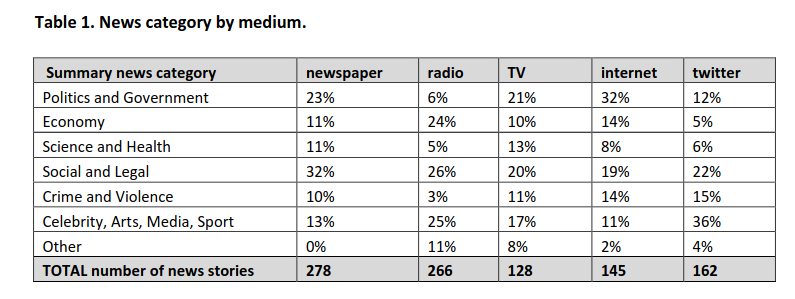
Defining Selected 17 News Genre
I have taken the definitions from ChatGPT. But maybe, we need to take it from some journal. Well, we will need it later on for ChatGPT based news classfication so we won't need such exact definition now.
- Politics: Covers political news, including national and regional politics, elections, government policies, and political analysis.
- Crime: Reports on criminal activities, law enforcement, legal proceedings, and related issues.
- Economy and Business: Focuses on economic policies, market trends, business developments, and financial news.
- Sports: News related to sports, including coverage of local and international sports events, player profiles, and analyses.
- International Affairs: Reports on global events and how they impact Bangladesh, including international politics, conflicts, and diplomatic relations.
- Health: Covers health-related news, including public health issues, medical advancements, and health policies.
- Education: News on the education system, policy changes, academic achievements, and issues affecting students and institutions.
- Culture and Entertainment: Includes news about the entertainment industry, cultural events, music, films, and celebrity news.
- Environment: Focuses on environmental issues, climate change, and natural disasters, with a strong emphasis on how these issues affect Bangladesh.
- Lifestyle: Covers topics related to everyday life, such as fashion, food, travel, and personal development.
- Technology: Reports on technological advancements, digital transformation, and tech-related news relevant to Bangladesh.
- Protests and Social Movements: News on civil unrest, protests, social movements, and public demonstrations.
- Human Rights: Focuses on issues related to human rights, including reports on abuses, advocacy, and related legal matters.
- Local News: Regional or local news that covers events and issues specific to different parts of Bangladesh.
- Religion: News related to religious events, practices, and issues affecting religious communities.
- Job: Discusses on career guidance, job postings and motivations.
- Science: Discusses scientific discovery, science for children and oddities.
Finding usual perspective from which newspaper articles are analyzed
For the longest time, newspaper articles have been analyzed manually by researchers. This has restricted the size of data they can process. So in this work, we identify the most famous perspectives from which newspaper articles are analyzed to detect discrimination.
- Presence of ethnography in major news area
- Straight, Investigative, Commentary or straight vs commentary
- Source of news information: subject, spokeperson, expert or commentator, personal experience, popular opinion, eye witness . or spokeperson, expert, victim .
- Agenda setting, framing, priming, mobilizing
We have also identified the following NLP metrics that require no validation to use them.
- Word Cloud: Words are displayed in various sizes, with more frequent words appearing larger. Useful for quickly identifying prominent terms in a text corpus.
- Term Frequency (TF): Simply counts the occurrences of each term. It's a straightforward way to assess which words are most common without needing a complex evaluation.
- Document Length: Useful for understanding the length of documents without requiring any complex processing.
- Word Length Distribution: Displays how many words of each length exist in the text, offering a glimpse into the text’s complexity.
- Vocabulary Richness: Measures the number of unique words relative to the total number of words. This can be a simple ratio (e.g., type-token ratio) and doesn't require complex evaluation.
- Keyword Extraction (without weighting): Extracts keywords based on basic criteria (e.g., frequency, presence in titles) without needing further validation.
- Basic Readability Scores: Calculated using simple formulas based on sentence length and word syllables (e.g., Flesch Reading Ease). These are standardized metrics and require no further validation.
- N-Gram Frequency: Useful for identifying common phrases or collocations without needing complex interpretation.
- Basic Sentiment Distribution: Shows the proportion of positive, negative, and neutral sentiments in the data, typically using a predefined dictionary or simple model.
- Topic Modeling (without validation): Using methods like LDA (Latent Dirichlet Allocation) to discover topics without detailed evaluation. The results can be interpreted as is.
- Part-of-Speech (POS) Tagging Distribution: Simple frequency counts of POS tags give an overview of the linguistic structure of the text.
- Basic Term Co-Occurrence: Provides insight into term associations without needing deep analysis.
Terminology
Under-representation, mis-representation or Representation Discrimination?
Let us look at existing literature to understand what is usually meant by under-representation and mis-representation.
Under-representation occurs when a particular group is not depicted in media, politics, or other public arenas in proportion to their actual numbers in the population.
Misrepresentation involves depicting a group in an inaccurate, stereotypical, or negative way. It refers to false or misleading portrayals that do not reflect the true nature, culture, or circumstances of the group.
Neither is happening from our findings so far. We found difference in news genre. We have not found any proof of negative stereotypes yet. So The term Representation Discrimination feels more accurate.
Experiment
We conduct numerous experiments since it is a sensitive topic to make claims on. The experiments are done over a long period of time so we follow the following meta data to store their results.
| Experiment name |
| Date |
| Objective |
| Result |
| Future Work |
| Artifacts (code, input data) |
Observe that, we do not stoe the output of the experiment because once can find that simply by running the code with that input data. Also, you can find our codebase in this github repository.
Task - Keyword Based Data Collection
This our curated dataset]] of ethnic word-contained articles from ebD- Bangla newspaper dataset. We have curated ethnic people related dataset using simply keyword based extraction. We considered the following keywords to filter out the articles.
ethnic_tribe_names = [
"চাকমা", "মারমা", "সাঁওতাল", "ত্রিপুরা", "গারো", "ওঁরাও", "তঞ্চ্যঙ্গা", "ম্রো",
"পাংখো", "চাক", "খেয়াং", "খুমি", "লুসাই","কুকি", "রাখাইন", "মণিপুরী",
"হাজং", "খাসিয়া", "মং", "বর্মন", "পাহাড়ি", "মালপাহাড়ি", "মুন্ডা", "ভূমিজ",
"কন্দ", "পাঙন", "লাওরা", "মুরং", "বাগদী"
] #"বম","কোচ","ডালু","কোল", "রাজবংশী", "পাত্র", "ভিল", "গণ্ড", "খাসি"
ethnicity_directed_words = [
"আদিবাসী" , "আদিবাসি" , "উপজাতি", "নৃগোষ্ঠী"
]
Following are the dimensions of resulting datasets.
| Dataset |
Size |
Approach |
Comment |
| eBD Bangla news |
2294710 articles |
- |
- |
| Curated Ethnic Word Dataset |
337793 articles |
Keyword Extraction |
Buggy, For list of articles, same list is added continuously. |
| Target Ethnic Articles |
14000 |
5 Keyword |
Topic modeling result came out bad due to repetition. |
| Curated Ethnic Word Dataset |
10187 |
Keyword Extraction |
Fixed the bug where same article was being added for each of its words |
| Most Relevant Articles |
221 |
5 Keywords |
|
TODO Failed Attempts
Word embedding model training on the whole dataset. This was a MAJOR blockage in our earlier work.
Experiment - Supervised Topic Modeling on Ethnic with Stemming
The only preprocessing we did was this -> to_remove = ['email\xa0protected', '\n\n\n\xa0\n\n\n\n\n', '\u200c্', '\n\n', '\xa0', '\n']. These are the top 10 topics we found in the articles.
Topic 0: "পার্বত্য" "চট্টগ্রাম" "উপজেলার" "ত্রিপুরা" "প্রাথমিক" "শিশুদের" "বিভিন্ন" "উন্নয়ন" "পাঠ্যপুস্তক" "চেয়ারম্যান"
Topic 1: "তঞ্চঙ্গ্যা" "সম্প্রদায়" "উৎসবকে" "তরুণীরা" "পাহাড়ের" "পুরাতন" "নেওয়ার" "লকডাউন" "বান্দরবানে" "সাঙ্গু"
Topic 2: "আদিবাসী" "পরিষদের" "আওয়ামী" "সভাপতি" "সম্পাদক" "বক্তব্য" "পার্বত্য" "আদিবাসীদের" "সাধারণ" "চেয়ারম্যান"
Topic 3: "বৈসাবি" "সাংগ্রাই" "সম্প্রদায়ের" "পাহাড়ি" "ঐতিহ্যবাহী" "এপ্রিল" "অনুষ্ঠান" "উৎসবের" "অনুষ্ঠিত" "প্রধান"
Topic 4: "জন্মদিনকে" "ছোটাছুটি" "নালন্দার" "দলবদ্ধ" "দলগতভাবে" "নৃত্যকলা" "জন্মদিন" "গ্যালারির" "চতুর্থতলায়" "নৃত্যসহ"
Topic 5: "বাংলাদেশে" "হিন্দু" "সাম্প্রদায়িক" "আক্রমণ" "সাম্প্রদায়িকতা" "ধর্মীয়" "কিন্তু" "লোকদের" "মুসলমান" "সাম্প্রদায়িকতার"
Topic 6: "গ্রামের" "উপজেলার" "মেহেরপুর" "জয়পুরহাট" "উদ্দিনের" "বেনাপোল" "পাঁচবিবি" "সাতক্ষীরা" "চুয়াডাঙ্গা" "নববর্ষ"
Topic 7: "পার্বত্য" "বিরুদ্ধে" "ভারতের" "বাহিনীর" "হিসেবে" "বাংলাদেশ" "উপজাতি" "সরকারের" "প্রবেশ" "নির্বাচিত"
Topic 8: "ক্ষুদ্র" "গোষ্ঠীর" "বাঙালি" "সংস্কৃতি" "বিভিন্ন" "ত্রিপুরা" "নিজস্ব" "বাংলাদেশ" "কিন্তু" "বাংলাদেশের"
Topic 9: "বাংলাদেশের" "আমাদের" "বাঙালি" "বাংলাদেশে" "বিভিন্ন" "বাংলাদেশ" "ধর্মের" "মানুষের" "ত্রিপুরা" "প্রশ্ন"
Clearly, stemming is needed here. We used SBNLTK Stemmer here because this project is the largest BNLP library and the developer seems pretty active. After stemming, we got the following topics.
Topic 0: "গোষ্ঠী" "আমা" "ক্ষুদ্" "পৃথিবী" "মেয়ে" "অধিকাংশ" "গুরুত্ব" "মানুষ" "অধিবাসী" "ত্রিপুরা"
Topic 1: "পার্বত্য" "চট্টগ্রাম" "আদিবাসী" "শিক্ষার্থী" "পরিষদ" "চেয়ারম্যান" "প্রাথমিক" "ক্ষুদ্" "সভাপতি" "শিশু"
Topic 2: "বাংলাদেশ" "হিন্দু" "ভারত" "বিরুদ্ধ" "সংখ্যালঘু" "নির্যাতন" "প্রশ্ন" "আক্রমণ" "কিন্তু" "সাম্প্রদায়িক"
Topic 3: "মুক্তিযোদ্ধা" "স্বাধীনতাযুদ্ধে" "জামুকা" "পদ্ধতিগত" "শিববাড়ি" "লক্ষ্যবস্তু" "কাক্সিক্ষত" "ইদ্রিস" "অ্যাম্বুশ" "করোইয়ে"
Topic 4: "উপজেল" "আওয়ামী" "ইউনিয়ন" "পরিবার" "উদ্দিন" "এলাকা" "সাম্প্রদায়িকতা" "স্থানীয়" "উপজেলা" "বিএনপি"
Topic 5: "সম্প্রদায়" "পাহাড়" "ত্রিপুরা" "অনুষ্ঠান" "শ্রেণি" "উৎসব" "সাংস্কৃতিক" "প্রধান" "তঞ্চঙ্গ্যা" "বাস্তবায়ন"
Topic 6: "পাহাড়" "আশ্রম" "বান্দরবান" "পরিবহন" "ব্যাখ্যা" "সাঙ্গু" "প্রকৃতি" "যাত্" "দূরত্ব" "ধর্মমত"
Topic 7: "অনেকদিন" "অভিনয়ের" "রফিকুন" "সনদপত্র" "সাইফু" "স্মৃতিকাতর" "স্লাইড" "হুটোপুটি" "অধ্যবসায়ী" "অনেককিছু"
Topic 8: "বাংলাদেশ" "বাঙা" "আমা" "বিভিন্ন" "মানুষ" "আদিবাসী" "ক্ষুদ্" "সাঁওতাল" "নিজস্ব" "জনগোষ্ঠী"
Topic 9: "গ্রাম" "সীমান্ত" "বিহার" "বর্ণমালা" "পদ্ধতি" "প্রাচীন" "দক্ষিণ" "মেহেরপুর" "ব্যবহার" "জয়পুরহাট"
DataFrame shape(10, 2)
Also, the following is our list of initial keywords.
ethnic_tribe_names = [
"চাকমা", "মারমা", "সাঁওতাল", "ত্রিপুরা", "গারো", "ওঁরাও", "তঞ্চ্যঙ্গা", "ম্রো",
"পাংখো", "চাক", "খেয়াং", "খুমি", "লুসাই","কুকি", "রাখাইন", "মণিপুরী",
"হাজং", "খাসিয়া", "মং", "বর্মন", "পাহাড়ি", "মালপাহাড়ি", "মুন্ডা", "ভূমিজ",
"কন্দ", "পাঙন", "লাওরা", "মুরং", "বাগদী"
] #"বম","কোচ","ডালু","কোল", "রাজবংশী", "পাত্র", "ভিল", "গণ্ড", "খাসি"
ethnicity_directed_words = [
"আদিবাসী" , "আদিবাসি" , "উপজাতি", "নৃগোষ্ঠী"
]
Experiment - Supervised Topic Modeling to find best Alpha score
We modeled coherence score against different alpha values of LDA model. For 10187 dataset, 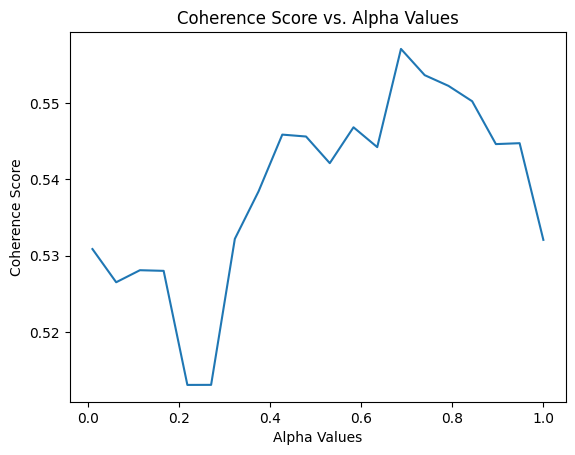 We had the highest coherence score for alpha value around 73. So we get our final topic list from an LDA with coherence score = 0.7394. The topic list is below.
We had the highest coherence score for alpha value around 73. So we get our final topic list from an LDA with coherence score = 0.7394. The topic list is below.
Topic 0: "গ্রেফতার" "পুলিশ" "অভিযান" "গ্রাম" "উদ্ধ" "উপজেল" "অভিযোগ" "ব্যবসায়ী" "বিরুদ্ধ" "এলাক"
Topic 1: "বিচারপতি" "হাইকোর্ট" "আইনজীবী" "কর" "আবেদন" "পুলিশ" "কর্মকর্তা" "মন্ত্রণালয়ের" "ওবায়দুল" "জেনার"
Topic 2: "পরিবার" "আক্রান্ত" "স্বাস্থ্য" "ত্রিপুরা" "হাসপাতাল" "ইউনিয়ন" "মৃত্যু" "বান্দরবান" "দুর্গম" "কর্মকর্তা"
Topic 3: "সম্পাদক" "সাধারণ" "সভাপতি" "পাপিয়া" "ছাত্রলীগ" "আওয়ামী" "সম্মেলন" "বর্তমান" "নরসিংদী" "কেন্দ্রীয়"
Topic 4: "আন্দোলন" "ছাত্রলীগ" "শিক্ষার্থী" "প্রধানমন্ত্রী" "দাবি" "সাধারণ" "বিশ্ববিদ্যালয়ের" "আন্দোলনকারী" "বিক্ষোভ" "বিশ্ববিদ্যাল"
Topic 5: "ব্যবস্থা" "সরকারি" "ক্ষেত্র" "বিসিএমসি" "মুক্তিযোদ্ধা" "নিশ্চিত" "প্রধানমন্ত্রী" "বাংলাদেশ" "সরকার" "মাধ্যম"
Topic 6: "পাহাড়" "পর্যটন" "পর্যটক" "বিভিন্ন" "কক্সবাজার" "পর্যন্ত" "স্থানীয়" "কর্মকর্তা" "নির্মাণ" "এলাকা"
Topic 7: "কাশ্মীর" "ভারত" "বাংলাদেশ" "ভারতী" "পাকিস্তান" "দি" "সংবিধান" "অনুচ্ছেদ" "মর্যাদা" "রাজ্য"
Topic 8: "ব্যাংক" "গ্রাম" "প্রকল্প" "বিভিন্ন" "বিক্র" "ব্যবস্থা" "কোম্পানি" "পর্যন্ত" "বিদ্যুৎ" "ব্যবস্থাপনা"
Topic 9: "চট্টগ্রাম" "আক্তার" "অভিযোগ" "পরিবার" "বিরুদ্ধ" "ব্যবস্থা" "কর্মকর্তা" "অফিস" "পুলিশ" "মামল"
Topic 10:"শিক্ষার্থী" "শিক্ষা" "আমা" "ইঞ্জিনিয়ারিং" "অ্যান্ড" "বিভাগ" "প্রতিষ্ঠান" "শিক্ষক" "পরীক্ষা" "ক্যাম্পাস"
Topic 11:"রোহিঙ্গা" "রাখাইন" "মিয়ানমারের" "সেনাবাহিনী" "বাংলাদেশ" "মিয়ানমার" "ক্যাম্প" "দেশ" "সীমান্ত" "জাতিসংঘ"
Topic 12:"এলাকা" "হাসপাতাল" "সন্ত্রাসী" "চাকমা" "ইউপিডিএফ" "খাগড়াছড়ি" "উপজেল" "ঘটনাস্থল" "উদ্ধ" "উপজেলা"
Topic 13:"প্রার্থী" "আওয়ামী" "বিএনপি" "নির্বাচন" "চেয়ারম্যান" "ইউনিয়ন" "উপজেলা" "উপজেল" "স্বতন্ত্র" "হয়েছেন"
Topic 14:"কিন্তু" "আমা" "মানুষ" "কর" "প্রশ্ন" "সেখান" "যা" "হিস" "সম্পর্ক" "দি"
Topic 15:"বাংলাদেশ" "বঙ্গবন্ধু" "মাধ্যম" "বিভিন্ন" "নাগরিক" "উন্নয়ন" "অনুষ্ঠান" "মুক্তিযুদ্ধ" "সমাজ" "আন্দোলন"
Topic 16:"উপজেলা" "চেয়ারম্যান" "কর্মকর্তা" "সভাপতি" "প্রধান" "বক্তব্য" "সভাপতিত্ব" "প্রশাসন" "সম্পাদক" "উপস্থিত"
Topic 17:"পার্বত্য" "চট্টগ্রাম" "আদিবাসী" "রাঙ্গামাট" "পাহাড়" "পরিষদ" "প্রধান" "ত্রিপুরা" "অনুষ্ঠান" "আঞ্চলিক"
Topic 18:"সম্পাদক" "চৌধুরী" "উদ্দিন" "অ্যাডভোকেট" "মোহাম্মদ" "প্রমুখ" "কুমিল্লা" "বক্তব্য" "সমাবেশ" "চট্টগ্রাম"
Topic 19:"সাংস্কৃতিক" "প্রশিক্ষণ" "অধ্যাপক" "পরিচালক" "অনুষ্ঠান" "শ্রদ্ধা" "শিল্পী" "একাডেমি" "কুমিল্লা" "মোজাফফর"
It is experiment on 5130 ethnic article. The topics are:
Topic 0 "প্রার্থী" "বান্দরবান" "নির্বাচন" "উন্নয়ন" "প্রতিবেদন" "নির্মাণ" "বিএনপি" "হয়েছেন" "মারমা" "প্রকল্প"
Topic 1 "বাংলাদেশ" "শ্রেণি" "আমা" "কিন্তু" "ক্ষুদ্" "ক্ষেত্র" "বিভিন্ন" "মানুষ" "সেখান" "হিস"
Topic 2 "মোহাম্মদ" "কক্সবাজার" "অতিরিক্ত" "কেন্দ্র" "আক্রান্ত" "পরিচালনা" "তাদের" "স্থান" "প্রস্তুত" "যুগান্তর"
Topic 3 "মামলায়" "চৌধুরী" "উদ্দিন" "আক্তার" "আব্দুল" "বঙ্গবন্ধু" "উদ্দীন" "আসামি" "সুলতানা" "উল্লাহ"
Topic 4 "আওয়ামী" "জেএসএস" "নেতৃত্ব" "জনসংহতি" "সমিতি" "নেতাকর্মী" "কাপ্তাই" "ছাত্রলীগ" "মহানগর" "সাধারণ"
Topic 5 "তঞ্চঙ্গ্যা" "বিশ্ববিদ্যাল" "বিশ্ববিদ্যালয়ের" "প্রবন্ধ" "ভূঁইয়া" "সার্বিক" "প্রকৌশলী" "সম্প্রসারণ" "নিজ" "কলকাতা"
Topic 6 "উপজেলা" "চেয়ারম্যান" "সম্পাদক" "সভাপতি" "কমি" "প্রধান" "অনুষ্ঠান" "পরিষদ" "বক্তব্য" "কেন্দ্রীয়"
Topic 7 "রোহিঙ্গা" "ঘটনাস্থল" "সেনাবাহিনী" "বাহিনী" "রাখাইন" "ক্যাম্প" "নিহত" "সশস্ত্" "সীমান্ত" "মিয়ানমারের"
Topic 8 "উপজেল" "ইউনিয়ন" "স্থানীয়" "এলাকা" "গ্রাম" "হাসপাতাল" "উদ্ধ" "প্রধানমন্ত্রী" "অভিযান" "পরিবার"
Topic 9 "আদিবাসী" "নির্দেশ" "সাঁওতাল" "গাইবান্ধা" "শ্রমিক" "বিক্ষোভ" "পশ্চিম" "উচ্ছেদ" "কর্মচারী" "পল্লী"
Topic 10 "২শালবন" "১৯১টি১" "৫মুক্তিযুদ্ধের" "৪বুদ্ধিজীবী" "৩৮উপরের" "৩৭কাকে" "২১বাংলায়" "২০মুক্তিবাহিনীর" "অনুমোদনকমলগঞ্জ" "১০জাতিসংঘের"
Topic 11 "পার্বত্য" "চাকমা" "চট্টগ্রাম" "পাহাড়" "সন্ত্রাসী" "ইউপিডিএফ" "ত্রিপুরা" "খাগড়াছড়ি" "রাঙ্গামাট" "শুক্রবার"
Topic 12 "সরকারি" "মাধ্যম" "শিক্ষার্থী" "রিপোর্ট" "বিভিন্ন" "পাশাপাশি" "সংগ্রহ" "কার্যক্রম" "সংগঠন" "প্রতিষ্ঠান"
Topic 13 "২শালবন" "১৯১টি১" "৫মুক্তিযুদ্ধের" "৪বুদ্ধিজীবী" "৩৮উপরের" "৩৭কাকে" "২১বাংলায়" "২০মুক্তিবাহিনীর" "অনুমোদনকমলগঞ্জ" "১০জাতিসংঘের"
Topic 14 "হত্য" "স্ত্রী" "কুমিল্লা" "নারী" "গাজীপুর" "ধর্ষণ" "ভ্রাম্যমাণ" "কিশোরী" "কারাদণ্ড" "ইনচার্জ"
Issues
- [ ] The topic did not seem coherent. However, maybe we can try ChatGPT4o help to better understand the topics
Artifacts
Experiment - Semi Supervised Topic Modeling on Ethnic, nonethnic
<2024-07-28 রবি> Objective: Since supervised topic modeling gave bad topics, let us try corex.
We collected 5342 ethnic articles from (4.4M->10132) news articles. We then used semi-supervised CoRex topic modeling. We used the following words as anchors.
anchors = [["ক্রীড়া", "রুপা", "স্বর্ণপদক", "ব্রোঞ্জপদক"], ["নির্বাচন","প্রার্থী", "চেয়ারম্যান"], ["পর্যটক"], ["উদযাপন", "নবান্ন", "উৎসব"], ["বিদ্রোহ", "কল্পনা"], ["মামলা"] , ["সরকার", "লুটপাট", "দুর্নীতি", "প্রশিক্ষণ"], [ "সেতু", "সংস্কার", "সংকট", "পানি"], ["বাংলাদেশ", "বিমানবাহিনী", "অফিসার", "ক্যাডেট"] ]
Later, we also collected exactly 5342 nonethnic articles for an equal comparison. The results are in result section below.
Result
The topic coherence (tc) score is 137.05506096485365. We also required 50 topics due to the sheer size of dataset. For docprob > 20.0, we found the following distribution of docs for 50 topics, summarized under 15 genre using ChatGPT-4o and manual supervision. 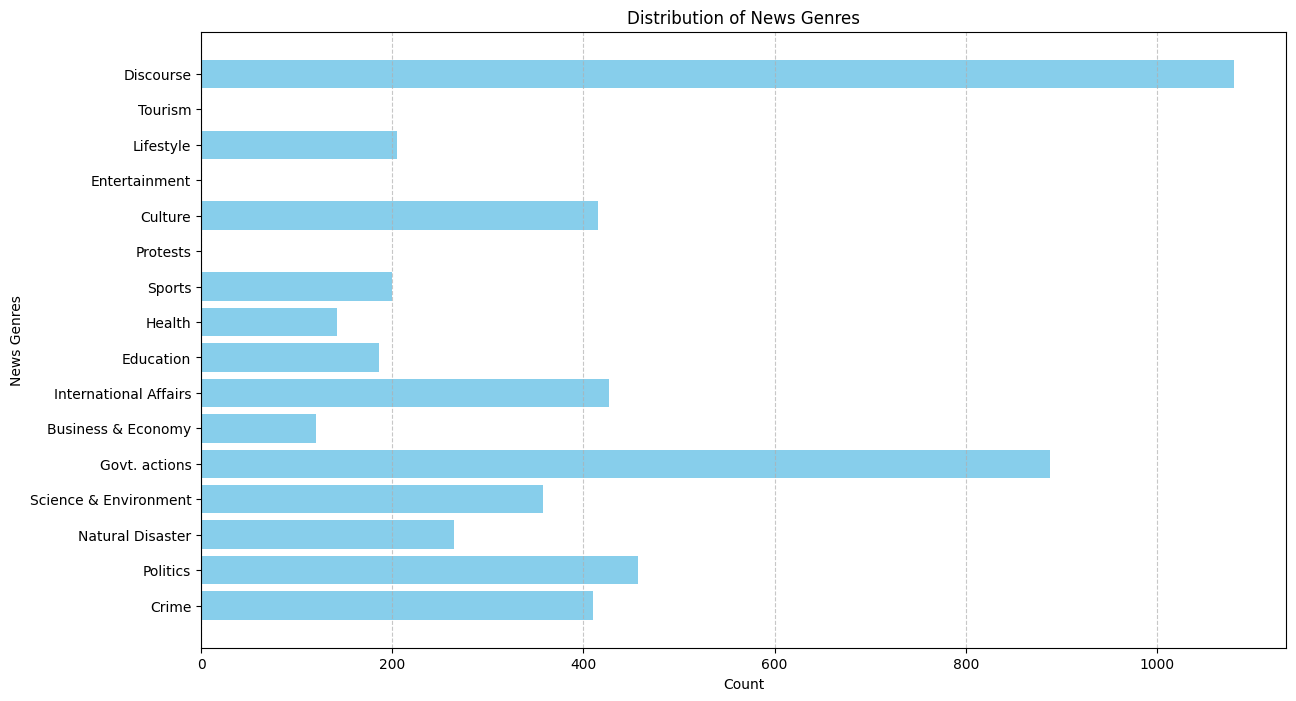
For 5342 nonethnic articles, the topic coherence score and individual docprob score came out very low. So for the SAME docprob > 20.0, we only got 1891 articles that are
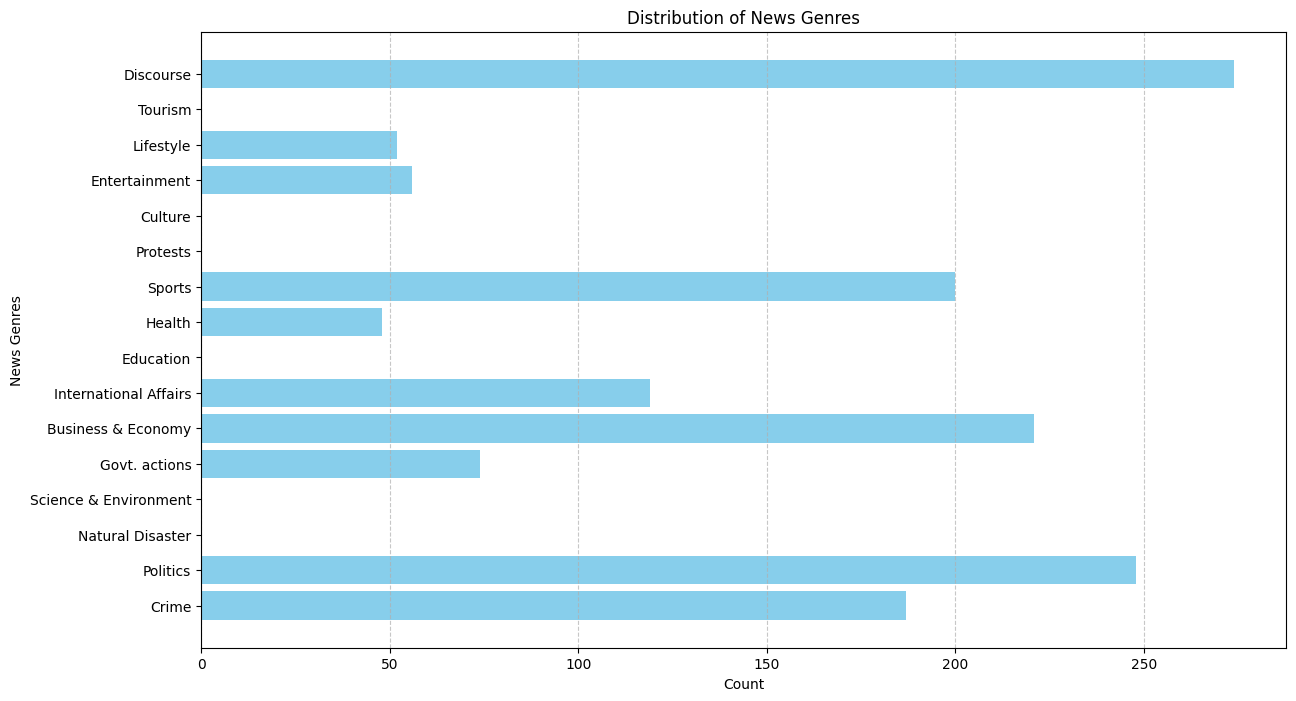
Issues
- [ ] why is tourism genre empty?
- [X] CoRex does NOT automatically assign docs to topics. It's a problem. So we had to do thresholding.
Artifacts
Task - Mass Annotation of 5342 Ethnic Articles
<2024-08-09 শুক্র> Objective: Quality data is necessary so we need to annotate to clean the data. Its also because of our definition of exact article.
I first did an exploratory analysis of the articles. When annotating, we paid close attention to why we are annotating the data as such by noting down the reason. It increased our understanding of the underlying data. We used the following interface for this stage of annotation and ended up annotating around 100 data.
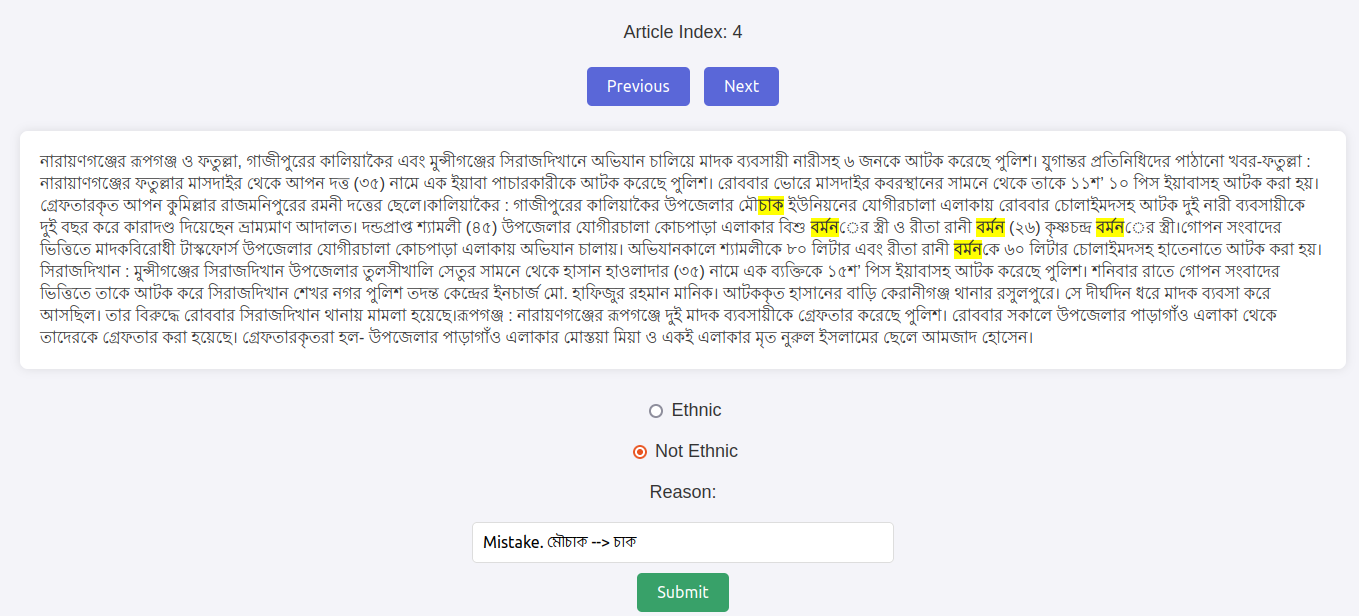
If we remember, we only did keyword based extraction to collect ethnic article dataset. To make it cleaner, we decided to annotate them manually and identify the exact articles which are about ethnic people. But annotating 5000+ articles is a mammoth undertaking. So we considerd keybinding - user will just see the article and press E/N to annotate ethnic, nonethnic. Usage of keybinding increase annotation speed significantly. But still, we annotated around 150 nonethnic articles. 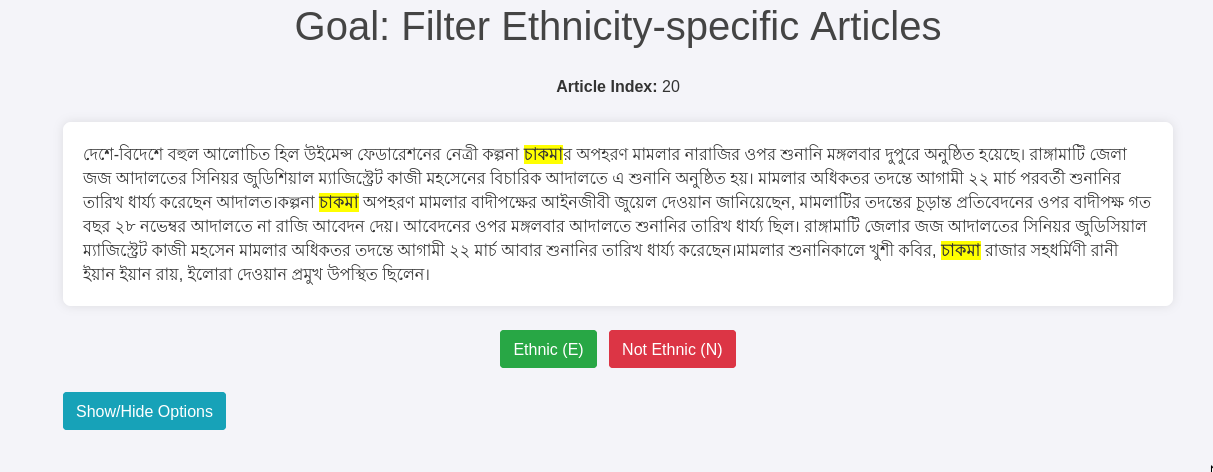
We also made one tool for easy understanding of Topics in Topic modeling by inspecting the documents in each topic.
Result
- Annotated 100 data with "why they are ethnic article or why not".
- Fast annotated 150 data with E or N.
- Simple annotation tool development
- Data understanding
Issues
- [ ] Finding literature on exact definition and loose definition
- [ ] Lets say, we annotate 5000 data. But there is no way to find another annotator to annotate 5000 data.
- [ ] I should use the topic document annotation tool more frequently
Artifacts
Experiment - Ethnic 100 articles with Gemini-1.5 Flash
<2024-08-14 বুধ> Objective: Seeing if gemini-1.5 flash free tier can be used for annotation
A major part of our experiment is genre classification. We have identified the following 15 genres: Crime, Politics, Natual Disaster, Sciene & Environment, Government actions, Business & Economy, International Affairs, Education, Health, Sports, Protests, Culture, Entertainment, Lifestyle, Discourse. Additionally, we also wanna find if the description is Straight, Investigation, Commentary.
Human are biased at annotating things they relate to. According to a journalist on his comment about LLM for news analysis, he said and I quote, "LLMs are the least biased journalist". So even without rigourous validation, we went with experimenting with Gemini-1.5 for news genre and news style annotation.
Result
We picked 100 articles from our 5132 ethnic news articles (which we extracted using keywords) and as we can see, most articles are on crime and discourse.

We tried to annotate non-ethnic articles as well but i think we soon ran out of free usage limit.
Issues
- [X] We observed that the keyword "Rakhain" resulted in the inclusion of Rohingya issue related articles. So we further cleaned our 5132 ethnic articles and ended up with around 4893 articles.
- [ ] We need to scale gemini based annotation. We need to understand what is the free tier limit and then, use multiple accounts to do it.
- [ ] We need to finalize on our few shot prompt instruction.
Artifacts
Experiment - Nonethnic 100k articles with Corex
<2024-08-15 বৃহঃ> Objective: Seeing if using more articles gives us a more complete distribution of usual news genre.
We collected 100k nonethnic articles from 4.4M news articles. We then used semi-supervised CoRex topic modeling. We used the following words as anchors.
anchors = [["ক্রীড়া", "রুপা", "স্বর্ণপদক", "ব্রোঞ্জপদক"], ["নির্বাচন","প্রার্থী", "চেয়ারম্যান"], ["পর্যটক"], ["উদযাপন", "নবান্ন", "উৎসব"], ["বিদ্রোহ", "কল্পনা"], ["মামলা"] , ["সরকার", "লুটপাট", "দুর্নীতি", "প্রশিক্ষণ"], [ "সেতু", "সংস্কার", "সংকট", "পানি"], ["বাংলাদেশ", "বিমানবাহিনী", "অফিসার", "ক্যাডেট"] ]
Result
The topic coherence (tc) score is 52.49676727298845. We also required 50 topics due to the sheer size of dataset. For docprob > 20.0, we found the following distribution of docs for 50 topics, summarized under 15 genre using ChatGPT-4o and manual supervision. 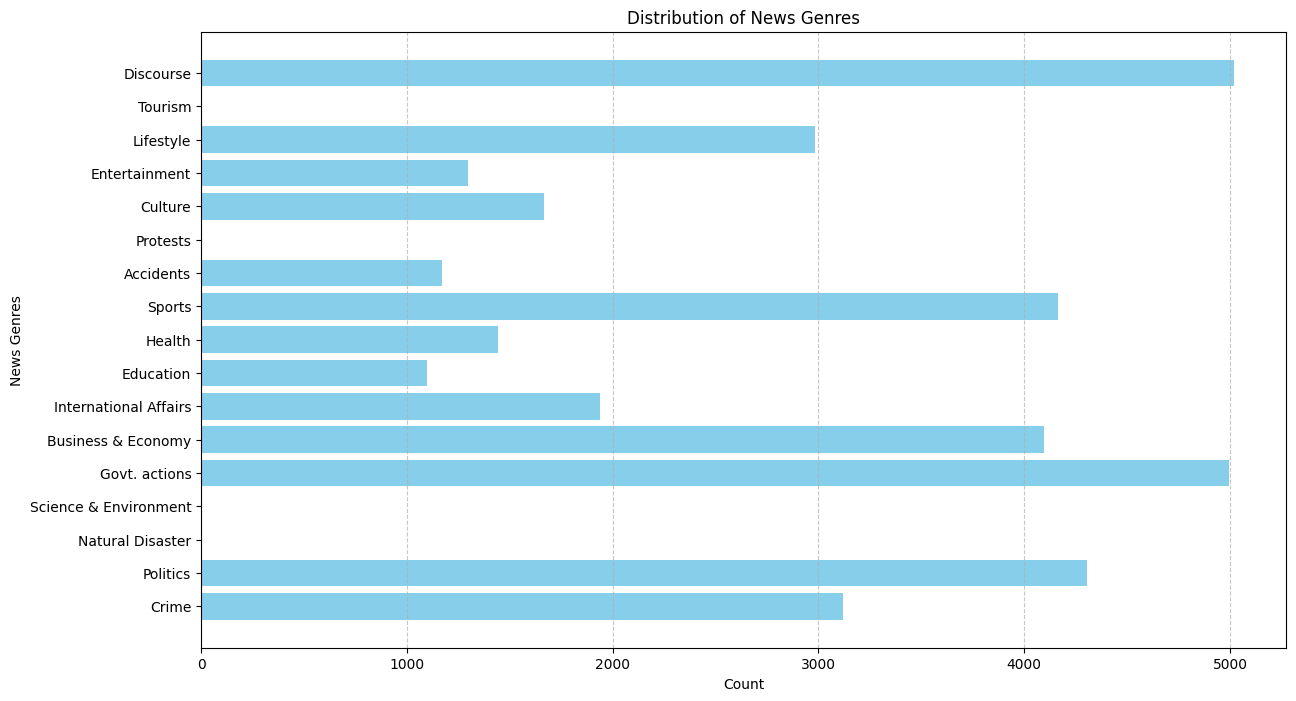
Issues
- [X] Increased maxvocabsize to 50k.
- [ ] Is topic coherence score low? If yes, why.
- [ ] The 15 genres we selected are not all-encompassing. Need to find some literature on it. Specially the
discourse genre. It is as if every news is a discourse.
- [ ] Need to pick better
Anchor words for each of the 15 genre.
Artifacts
Experiment - Ethnic (4893) with Corex
Objective: Getting a final result on ethnic people related articles' topic distribution.
Since we are using CoRex, anchor words selection is an important phase. So we first select generic words as anchor words and then select ethnicity specific ethnic words. We will see what performance difference there is. Note: We did not do it. Because it would add bias to the process. For such a critical topic, we want to do it as unbiased as possible.
Note that, we increased threshold to 25.0 here since docprob was higher for overall distribution.
Result
We achieved a topic correlation score of 143.63331714565578. Following is our result for CoRex Semi-Supervisd topic modeling on 4893 ethnic data. 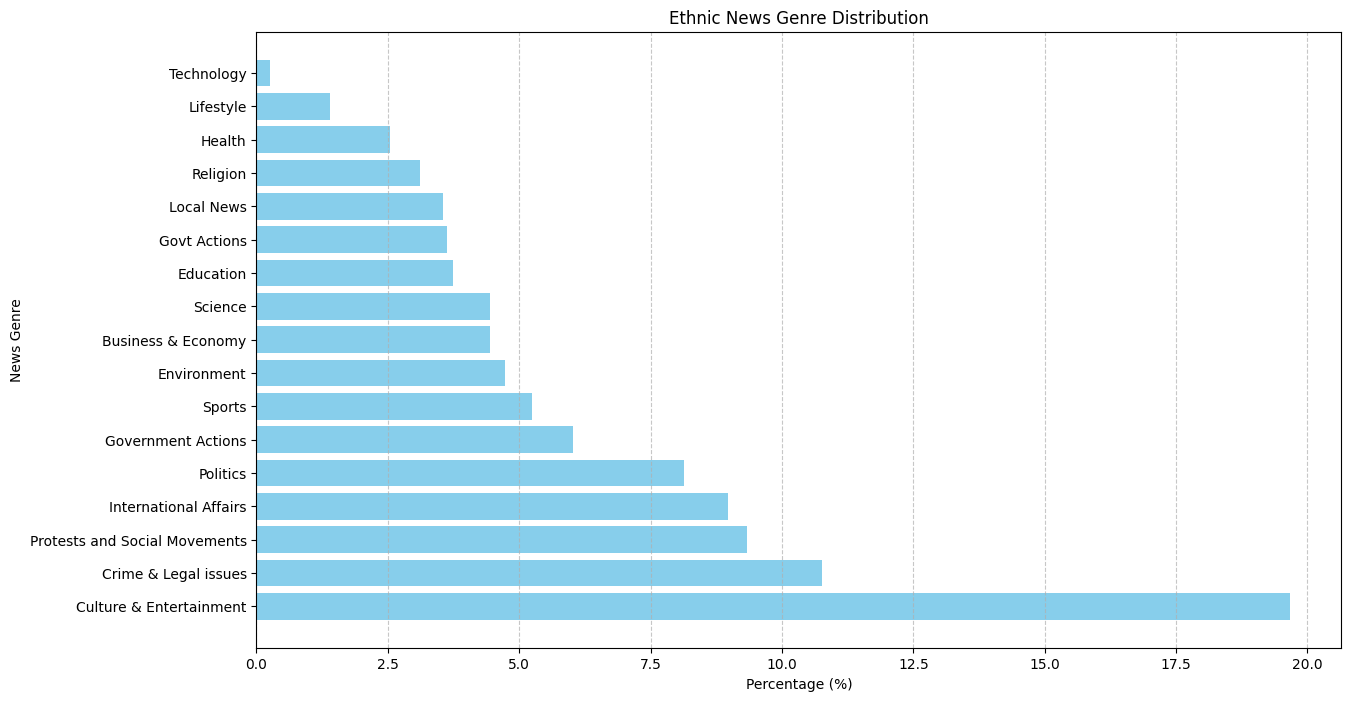
Issue
- [ ] Do I need to use multiple annotator for topic interpretation?
Artifacts
Experiment - Bangla news distribution (100k) with Corex
Objective: Getting a final result on usual news topic distribution in Bangla.
Result
Following is our result for CoRex Semi-Supervisd topic modeling on 100k sample articles from our original 4.4M articles. We achieved a topic correlation score of 55.4916729561928. 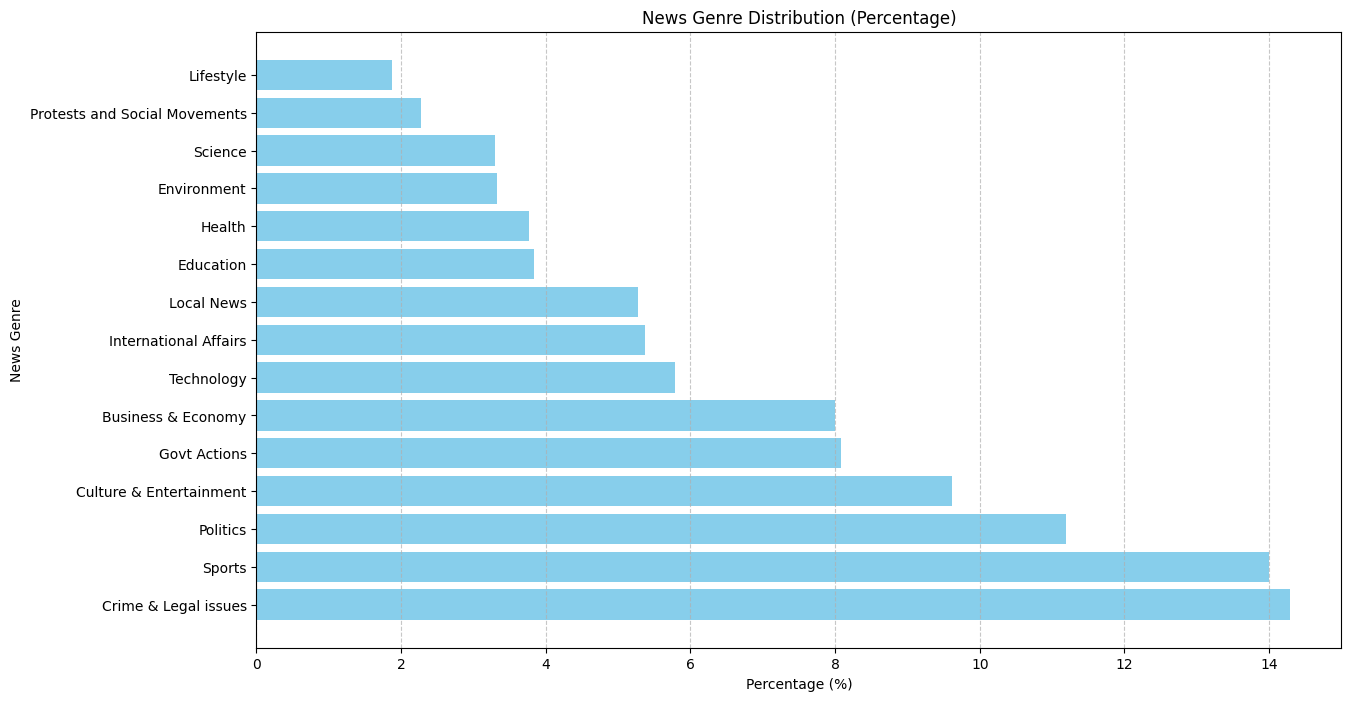 We validate our news genre distribution against work by Ross, Karen, et al. Their news genre distribution strongly correlates with our findings, except Sports genre . BD culture have strong feelings regarding sports, speciall football and cricket. So it explains away our distriution.
We validate our news genre distribution against work by Ross, Karen, et al. Their news genre distribution strongly correlates with our findings, except Sports genre . BD culture have strong feelings regarding sports, speciall football and cricket. So it explains away our distriution. 
Issue
- [ ] A lot of articles were discarded later on (From 100k documents, only 33k documents had docprob > 25.0. After removing garbage topics, the number of final documents in consideration decreased even further. Ig those are good data? Or is it a flaw? In fact, among 50 topics, 22 topics were garbage.
Artifacts
TODO Experiment - Combined 100 articles with Gemini-1.5 Flash after defining each genre.
<2024-08-14 বুধ> Objective: Seeing if gemini-1.5 flash free tier can be used for annotation Because all ethnic news articles can be called local news and that is not meaningful for us. So we add ""
You are a Bangla news article analyzer. I will give you a news article and you will say which genre(s) it belongs to. The genres are: Politics, Crime, International Affairs, Business & Economy, Sports, Culture & Entertainment, Jobs, Lifestyle, Health, Environment, Local news, Education, Technology, Religion, Science, Protests and Social Movements, Govt Actions. Additionally, you will also say if the description is Straight, Investigation, Commentary. Identify the perspective of any ethnic person mentioned in the article, choosing from the following categories: Subject, Spokesperson, Expert or Commentator, Personal Experience, Popular Opinion, Eyewitness. Return me just a json of {\"genre\": GENRE, \"description_style\": STYLE, \"perspective\": PERSPECTIVE}. Note that, each news will have at most 3 genres, ideally 1.
Result
Failed! Because of quota limit. Gemini would stop after processing 15 articles. (IDK why).
Issues
- [ ] Should i get one genre or multiple genre?
- [ ] Try chatGPT and Gemini to compare which is better.
Artifacts
Experiment - H0: There is no difference in size between ethnic and normal articles.
Atuel, Hazel et al provided a work very similar to ours in their work on majority and minority representation . They showed topic distribution, ethnic article count and ethnic article size as a means to understand media representation. So we now try to find prove the hypothesis.
| Ethnic |
4893 |
440.65563049254035 |
| Nonethnic |
100k |
124.93548193554193 |
Using Welch's t-test, p-value = 1.840763388749358e-195. For level of significance 0.05, we reject the H0.
We also do some wordclouds here. For remove_stopword phase, we used a dictionary of stopwords, along with len(word)>3.  For
For len(word)>5, the word cloud is: 
Artifacts
Experiment - Word Cloud for each Topic
Topic based word cloud did not work as expected, even though we rechecked stop word removal step. We think word cloud won't give us useful insight here because we use keyword based approach to select the ethnic articles. And thanks to that, not all articles are entirely ABOUT ethnic people. They just contain the name of ethnic minorities. 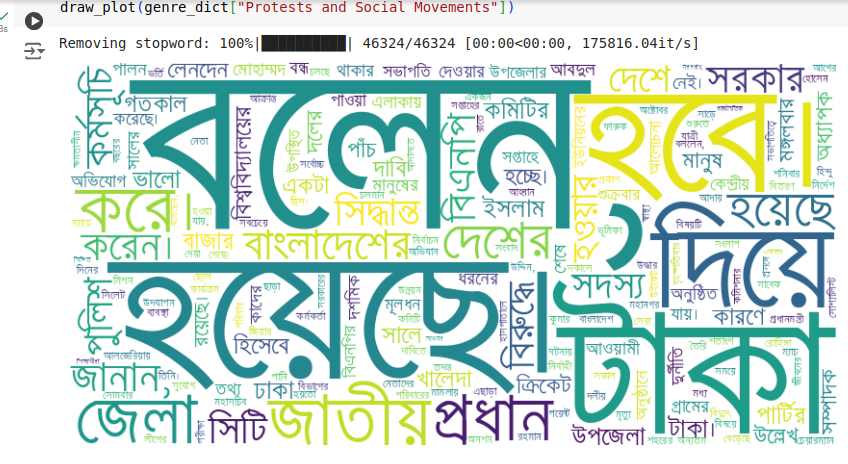
Artifacts
Experiment - Bangla News Sentiment Analysis
We use pretrained models from hugging face for this task. CSEBuetnlp published a similar Sentiment analysis using LLM paper recently . CUET also has a very nice data crawler and sentiment analysis code .
Result
It was a failure. We could not run any reliable model. We also think that sentiment won't give us any interesting result. Because it is not that bengali is extremely prejudiced towards Ethnic minorities, which is the case for western racism and such. They are just under-represented, often without malicious intent from publisher's part and more due to ignorance. For skl25/banglabert-sentiment,  This model underfits for
This model underfits for Negative sentiment. Even for "I hate you", it returns positive sentiment.
Issues
- [ ] How to cite hugging face models?
- [ ] Do we need to evaluate existing pretrained model?
- [ ] Tensorflow version conflict in SBNLTK. Also GDown not working in SBNLTK since the referred model files dont exist anymore.
Artifacts
Experiment - Word Cloud for each Topic after bug fixing
In earlier versions, we did not handle punctuations so we had some noises. In this version, we handle punctuations and also, some more stopwords. The output is less noisy.
For total 4893 ethnic articles: 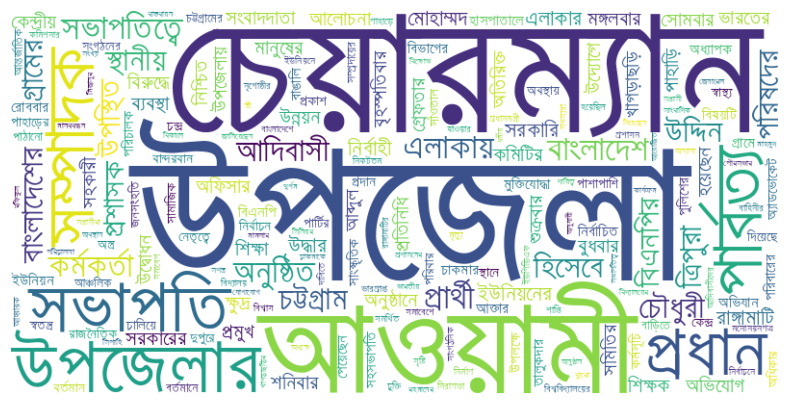 For govt actions topic:
For govt actions topic:  For protests topic:
For protests topic: 
Issues
- Its still noisy since we did consider keywords only. We MUST do cleaning of data to get better results.
Artifacts
Experiment - Finding ethnic articles using ChatGPT Turbo
Our performance of isethnic:
| gpt-4o-mini |
4/5 |
Less Diverse |
Straight |
Less Diverse |
LGTM |
prompt |
| gpt-3.5-turbo |
5/5 |
Diverse |
Straight |
Diverse |
LGTM |
result , prompt |
| gemini-1.5-turbo |
|
|
|
|
|
|
| gpt-4o-mini (512ctx) |
4/5 |
Subject |
Diverse |
Diverse |
LGTM |
prompt |
| gpt-3.5-turbo (512ctx) |
4/5 |
Diverse |
Diverse |
Negative |
LGTM |
prompt |
Now we really only need isethnic field. The rest 7 are just considering our cost, nothing else. So lets use gpt-3.5-turbo to get results for 100 articles.
| gpt-3.5-turbo, ctx512 |
0.54 (40) |
gpt-35-turbo-prompt-v2.txt |
15/25 ,6/14 |
result |
| gpt-4o-mini, ctx512 |
0.74 (40) |
gpt-35-turbo-prompt-v2.txt |
19/25, 10/14 |
result |
| gpt-3.5-turbo, ctx10k |
0.77 (40) |
gpt-35-turbo-prompt-v2.txt |
22/25 , 8/14 |
result |
| gpt-4o-mini |
0.74 (40) |
gpt-35-turbo-prompt-v2.txt |
20/25, 9/14 |
result |
Note that, max contest length of gpt-3.5-turbo is 16385.
From above table, we are sure that we can use gpt-3.5-turbo efficiently for our task. Now let us see if including more information reduces accuracy.
| gpt-3.5-turbo, ctx10k, with other |
0.72 (40) |
gpt-35-turbo-prompt-v2.txt |
23/25 , 5/14 |
result |
So we pick gpt-3.5-turbo ctx10k finally.
Annotation
<2024-09-13 শুক্র>
- For perspective, we need the name of the author.
- I myself do not know what each class represents when doing manual annotation. We need to define each class.
- Is Sentiment relevant for newspaper data analysis? Most news are about poitics, crime and sus. VERY few are about happy news. So we should not notice any difference between two groups' sentiment distribution.
- Turbo may perform bad for zero-shot. Let us try few-shot prompting.
We finally ended up annotating isethnic label only. We had an aggrement score of 75% between 2 authors over 100 articles. The conflicts were resolved through manual supervision. The resulting final annotation is here. The conflict was mainly in terms of whether ethnic awami league news are ethnic news or not. They ARE ethnic news since they represent the political aspect of their life.
Artifacts
| Annotated Dataset |
Link |
| Abhi annotation |
Link |
| Sharif annotation |
Link |
Experiment - Finalizing ChatGPT Turbo
<2024-09-13 শুক্র> annotation data: 100, two annotator, 75% agreement score, (Yes=63, No=37)
| gpt-3.5-turbo, ctx10k |
ethnic-only-prompt-v2.txt |
62% |
71.9 |
65.1 |
68.3 |
link |
| gpt-4o-mini, ctx 10k |
ethnic-only-prompt-v2.txt |
78% |
81.5 |
84.12 |
82.8 |
link |
| gpt-3.5-turbo, ctx10k |
combined and formal prompt.txt |
72% |
72.15 |
90.5 |
80.2 |
link , all metrics |
| gpt-4o-mini |
combined and formal prompt.txt |
67% |
65.5 |
100 |
79.24% |
link , all metrics |
| gpt-4o-mini, ctx 10k |
combined and formal prompt.txt |
69% |
67.02 |
100 |
80.25 |
link , all metrics |
| gpt-4o-mini, ctx 10k |
chatgpt4o-mini-prompt-v1.txt |
70% |
67.7 |
100 |
80.7 |
link , all metrics |
| gpt-3.5-turbo, ctx10k |
chatgpt4o-mini-prompt-v1.txt |
72% |
76.9 |
79.4 |
78.13 |
link , all metrics |
| gpt-3.5-turbo, ctx10k |
combined and indigenous.txt |
77% |
81.3 |
82.5 |
81.9 |
link ,all metrics |
GPT 4o greatly overfit to TRUE class for combined prompt v1, hence performing terribly. DONE ANNOTATING! There was a small mishap midway, anyway, here is the 4893 annotated ethnic article
DONE ANNOTATING! Here is the 5k regular news articles with some missing values.
Issues
- Prompt engineering is a hard trial-and-error practice.
Experiment - EDA on ChatGPT Turbo Annotation
The topic distribution is as follows: 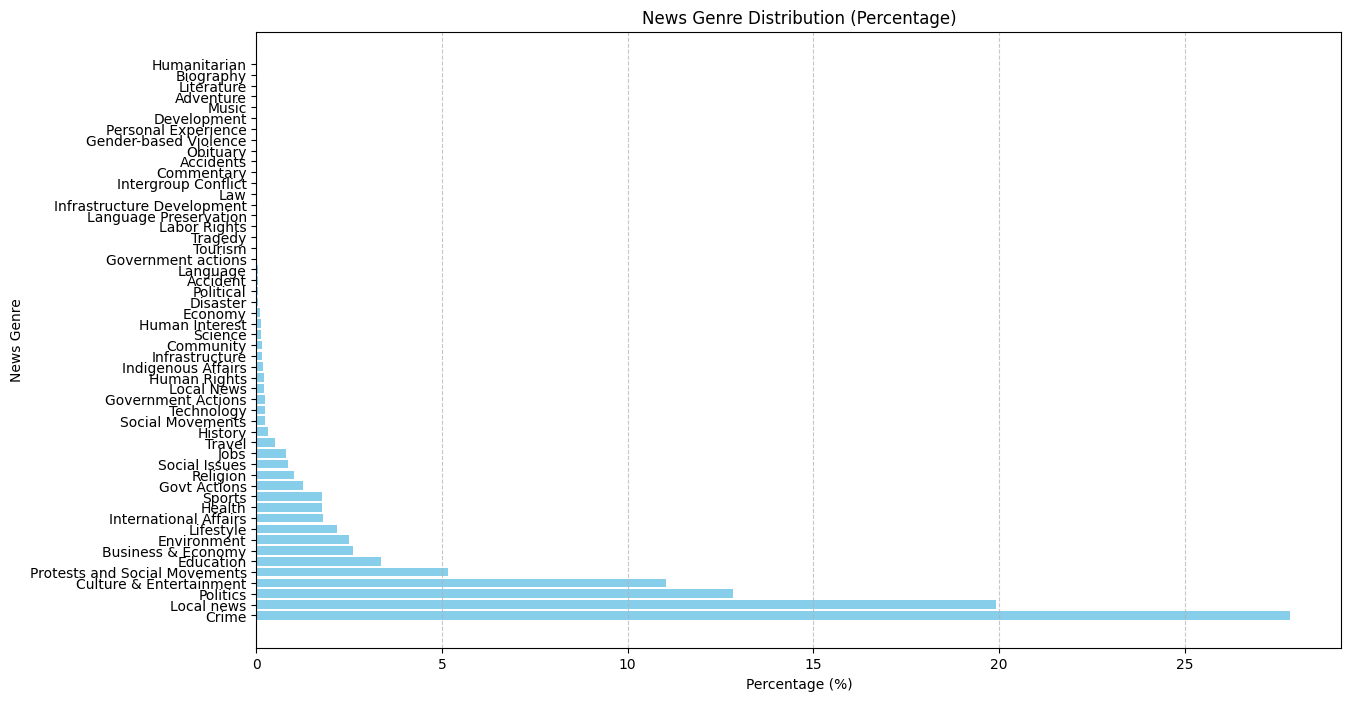
For description stye: 
For featured: 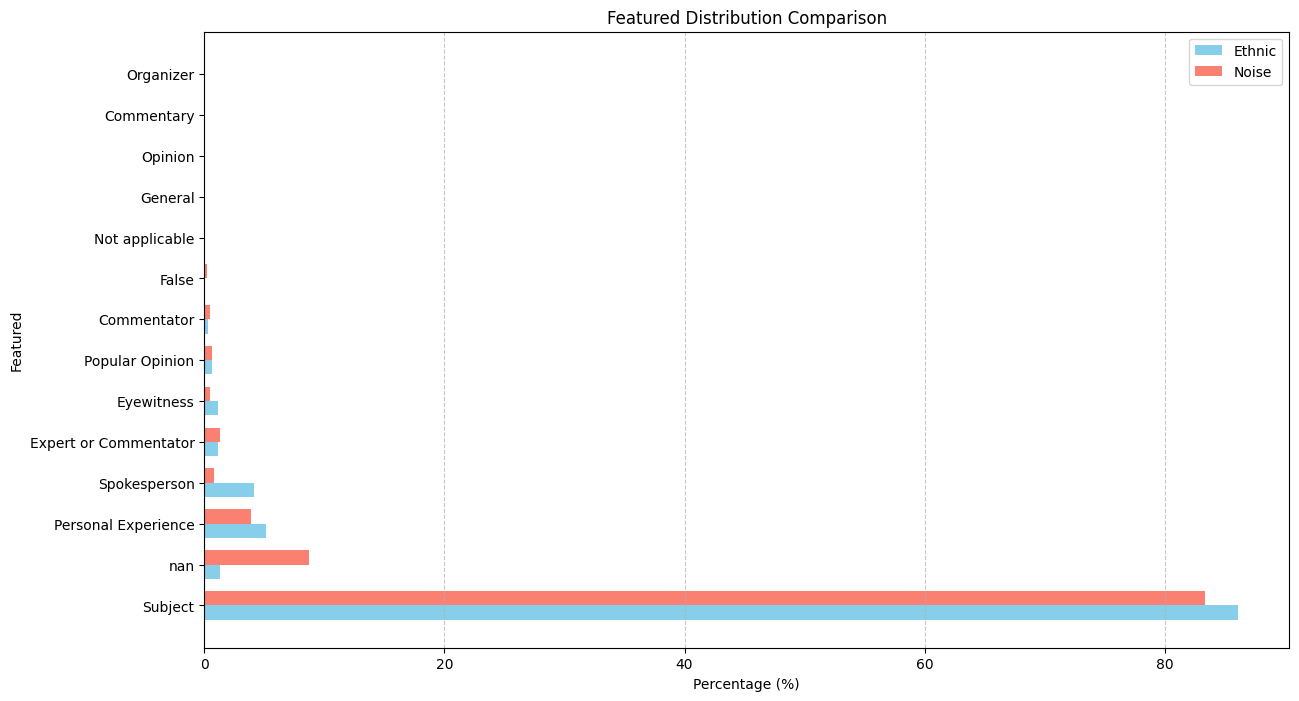
For sentiment: 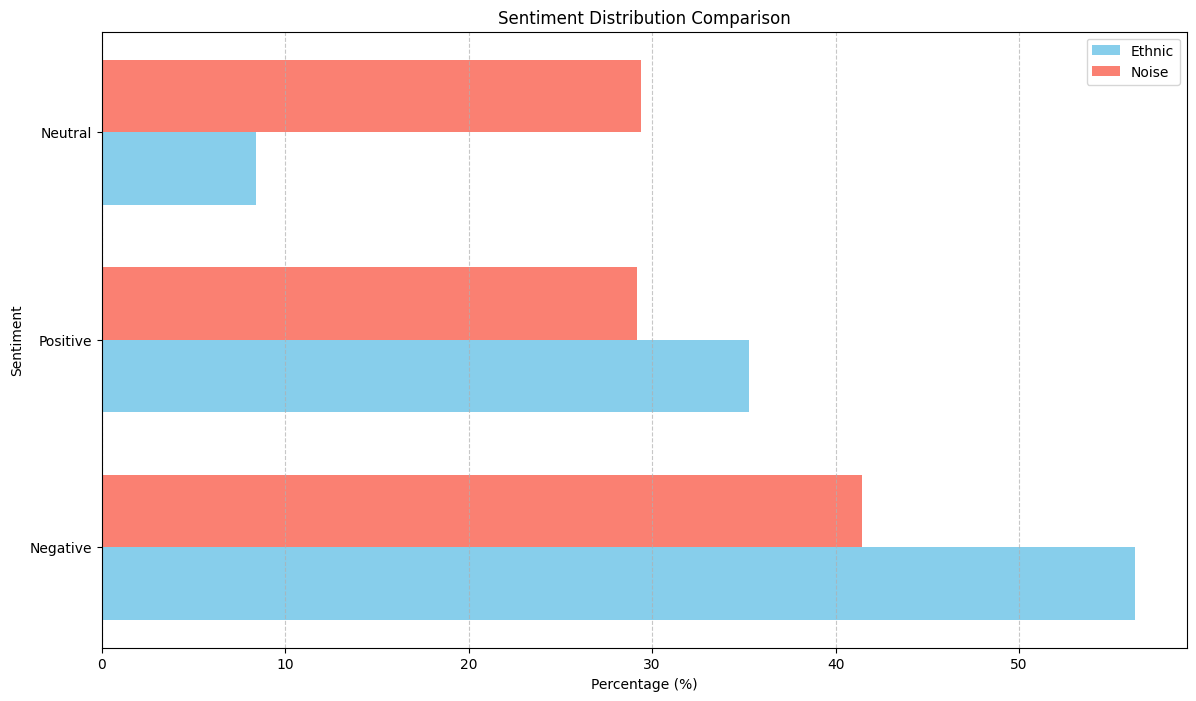
Top 40 agenda setting: 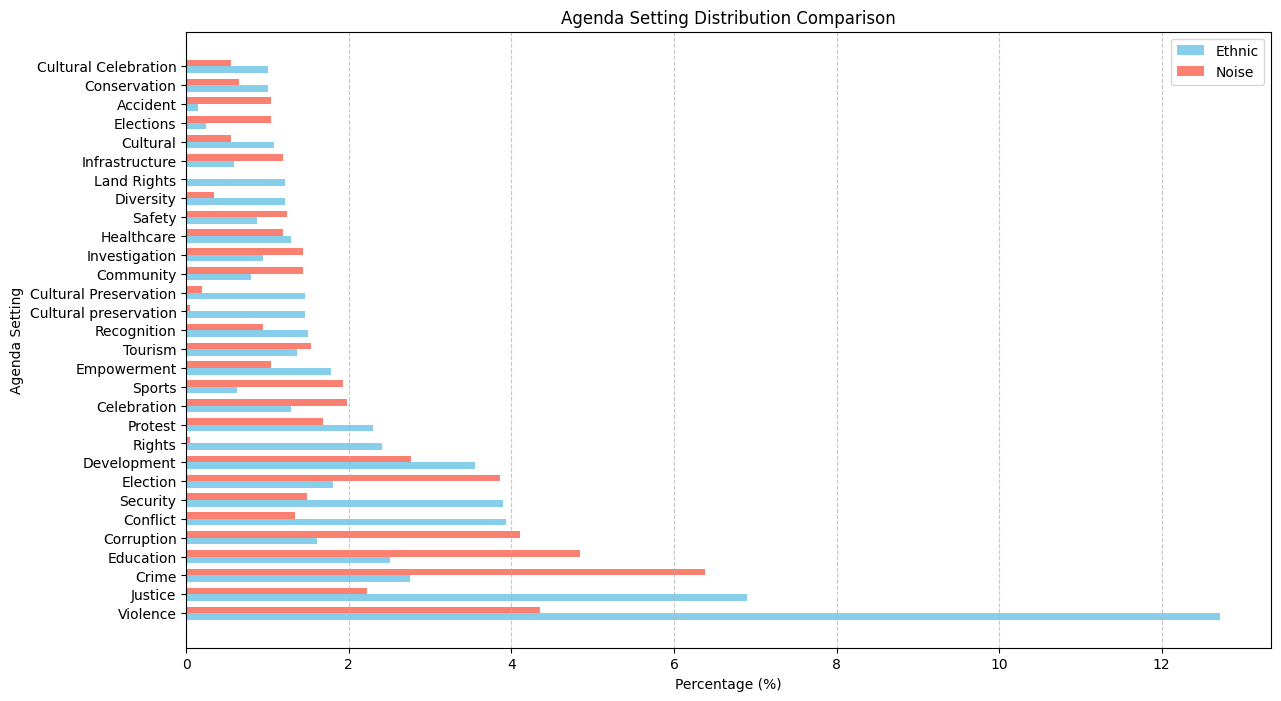
Top 40 framing : 
Top 40 priming: 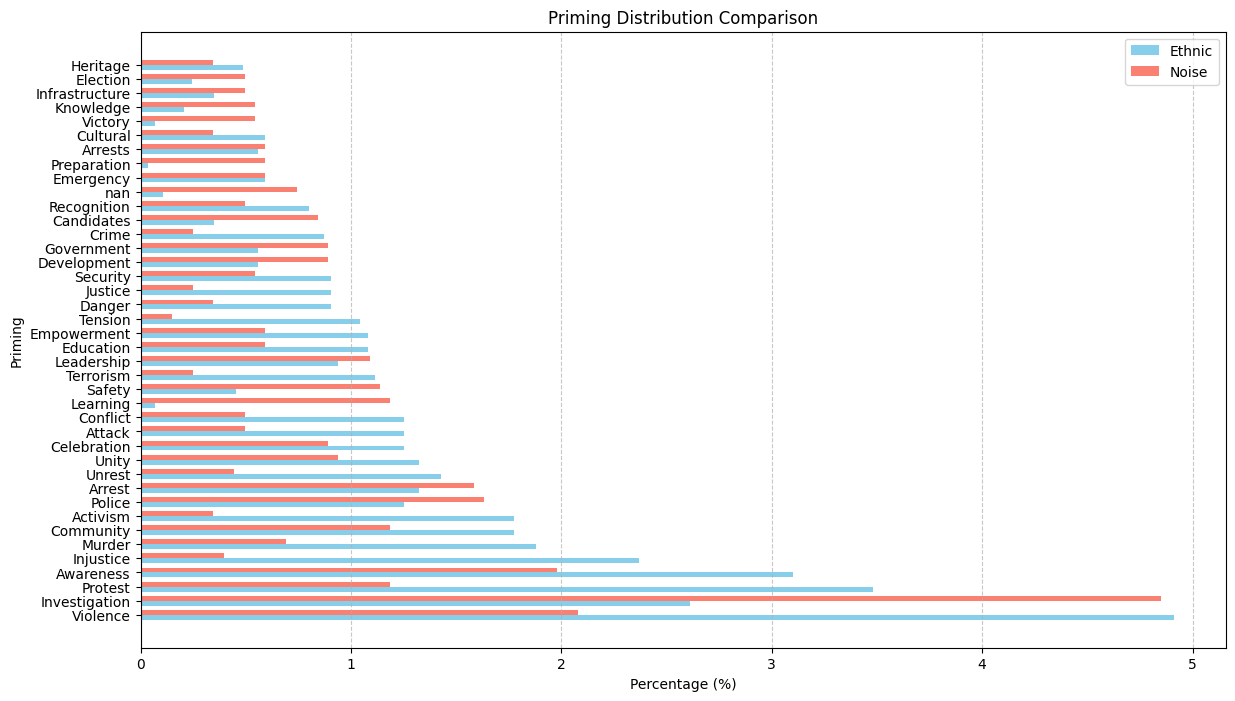
Top 40 mobilization: 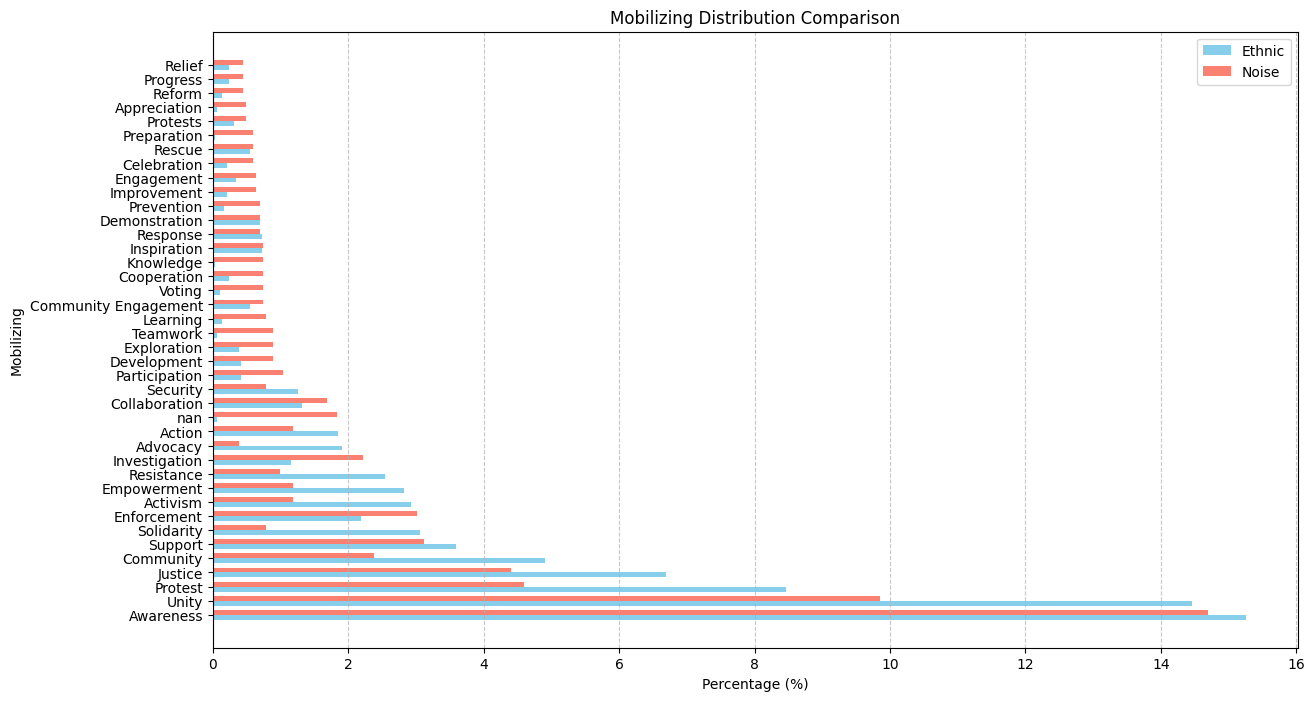
Experiment - Topic modeling, word cloud in curated dataset
The topic coherence score was high (114.78088415347356) and we used the same threshold as usual. And sports, health, local news, science, religion contents are not ABOUT ethnic people, they are just part of it. 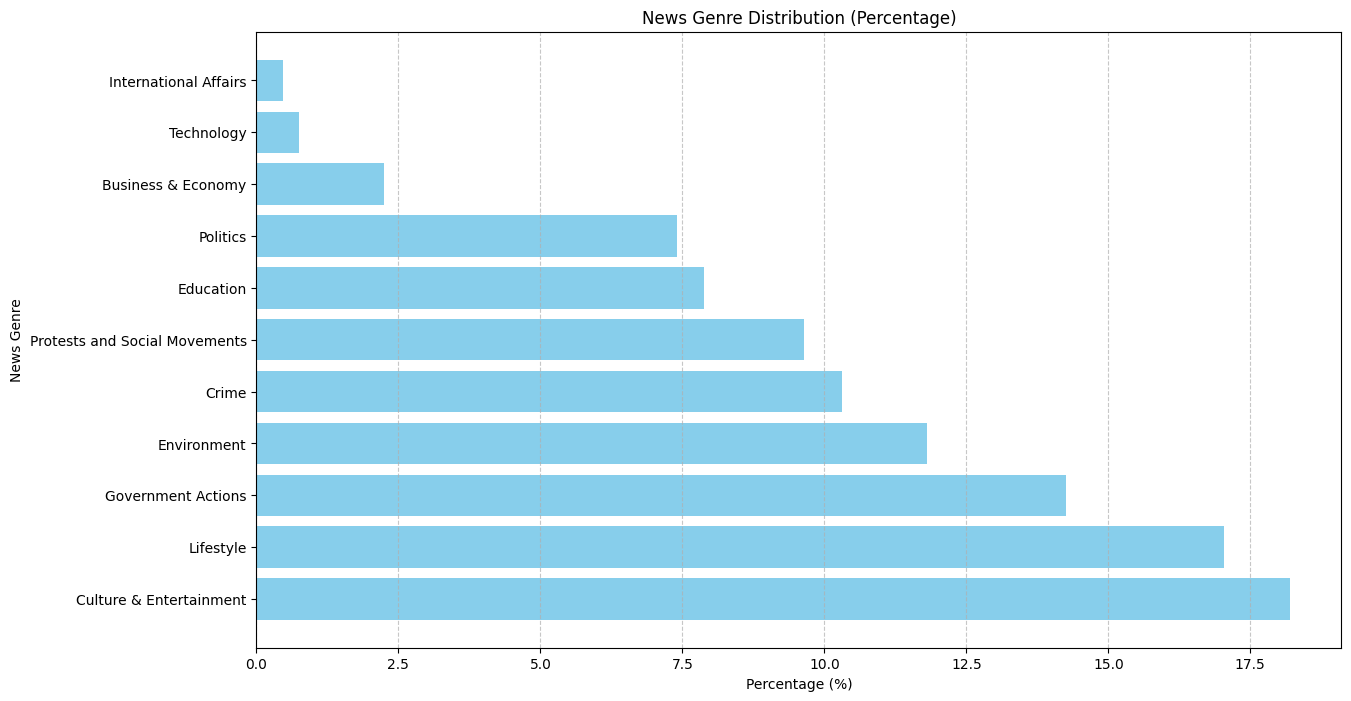 This topic distribution provides stronger support against our hypothesis. Now let us do word cloud. For protest and conflict, we got the following word cloud.
This topic distribution provides stronger support against our hypothesis. Now let us do word cloud. For protest and conflict, we got the following word cloud. 
For govt actions: 
For crime: 
For politics: 
For education: 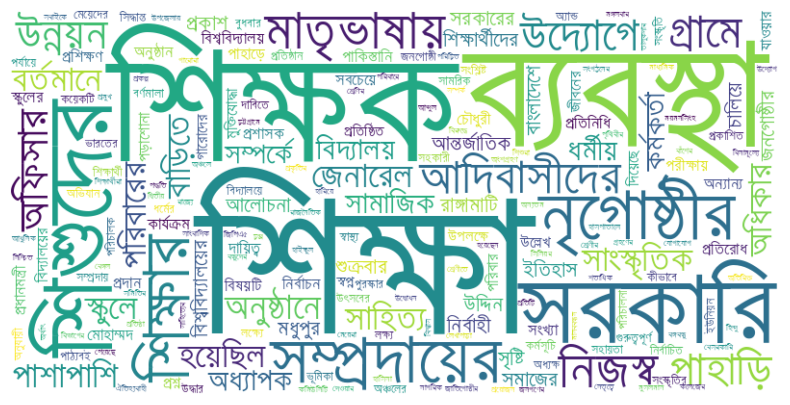
For technology (Observe "Mobile terrorist"): 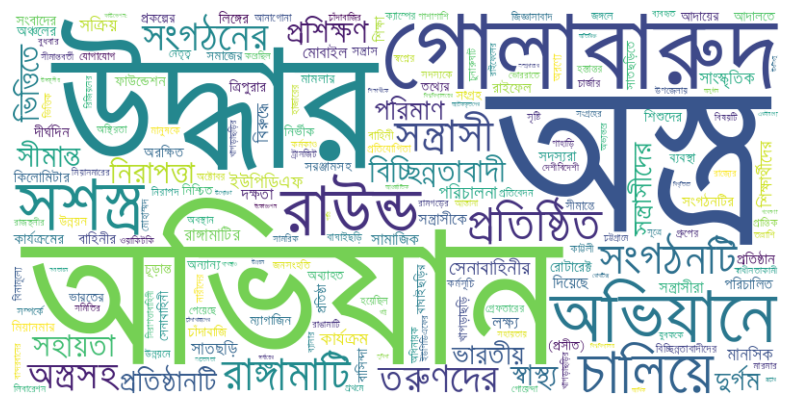
Experiment - EDA on both ChatGPT Turbo Annotation
For news genre:
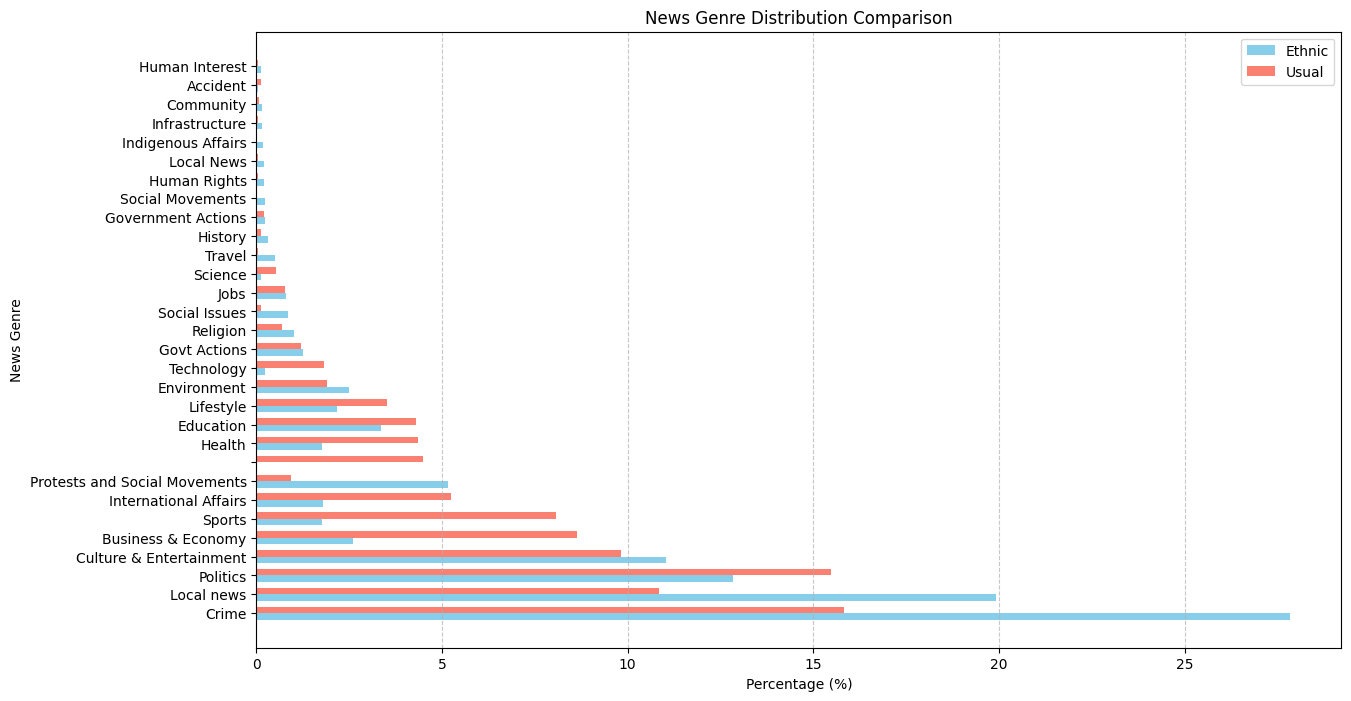
However, we observed no difference in journalism style! 
Who is featured? The answer feels noisy due to prompting issue. 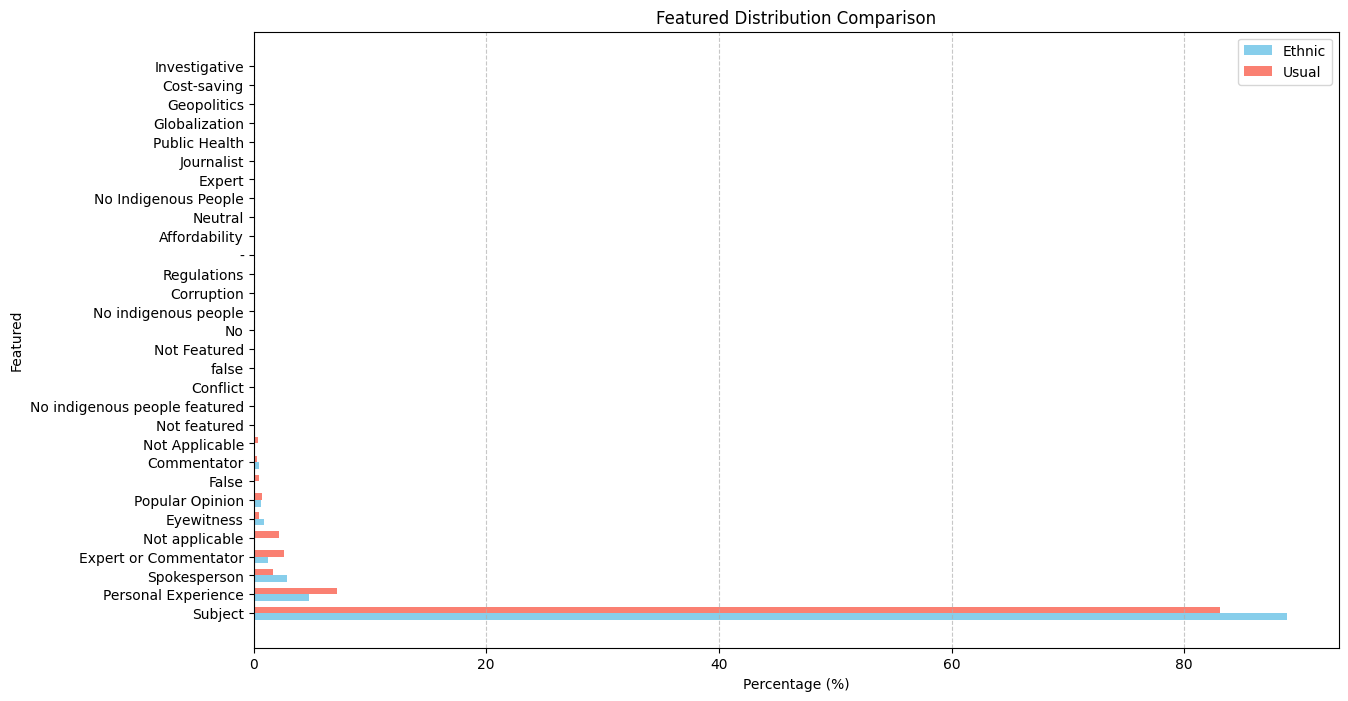
Most posts on ethnic people have negative sentiment. 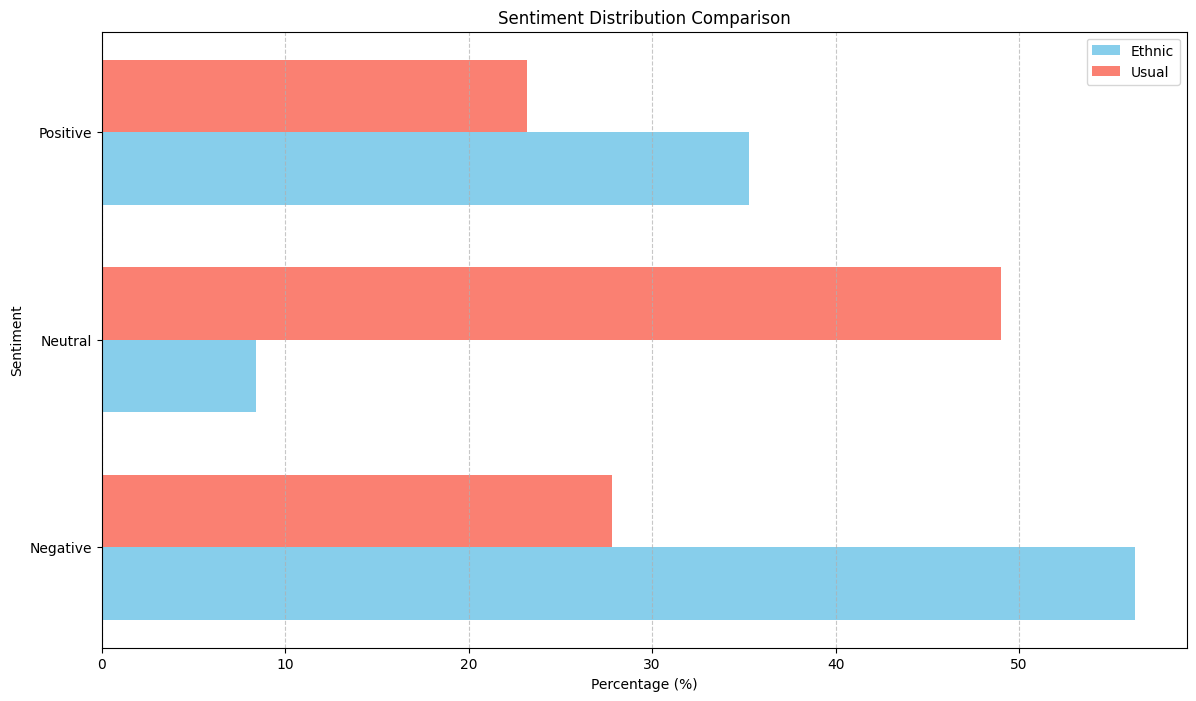
Agenda setting for ethnic people is violence. Dataset 1: 36.50% Dataset 2: 53.89% 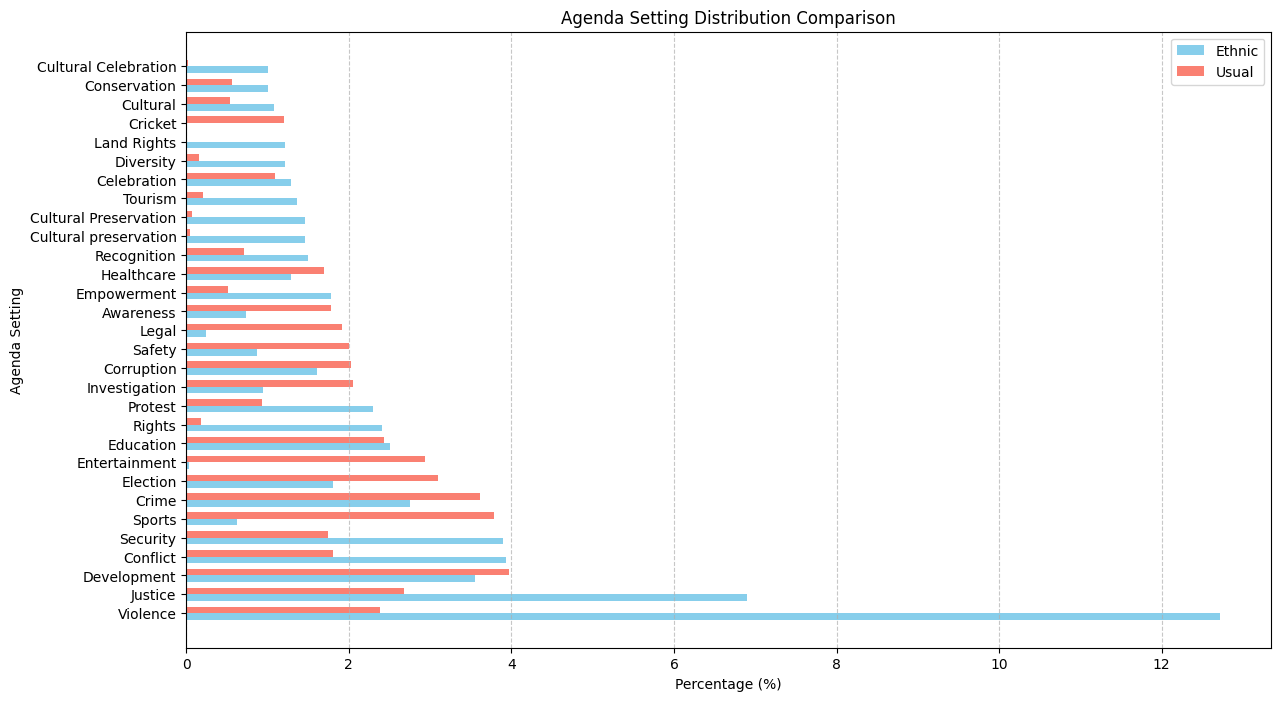
For framing, Conflict is the main frame. Dataset 1: 48.87% Dataset 2: 65.56% 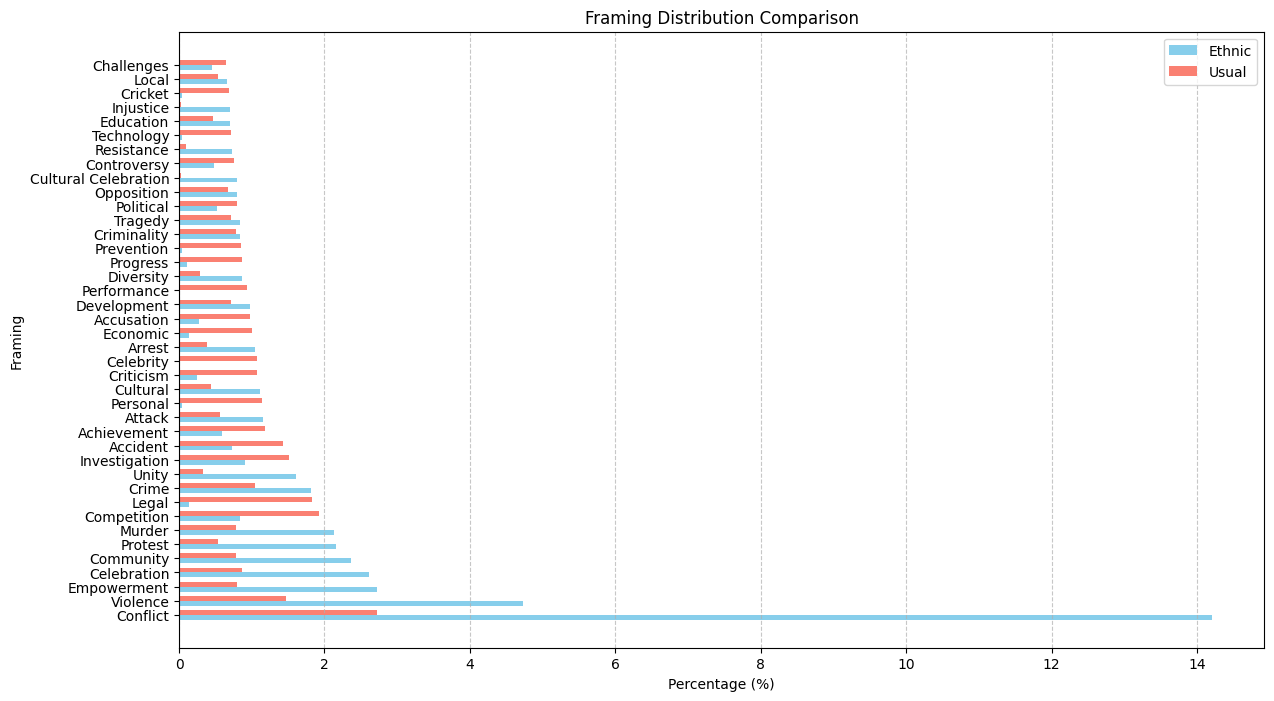
For priming, Violence is the major priming for ethnic article while investigation is the major priming for normal articles. Dataset 1: 19.44% Dataset 2: 33.22% 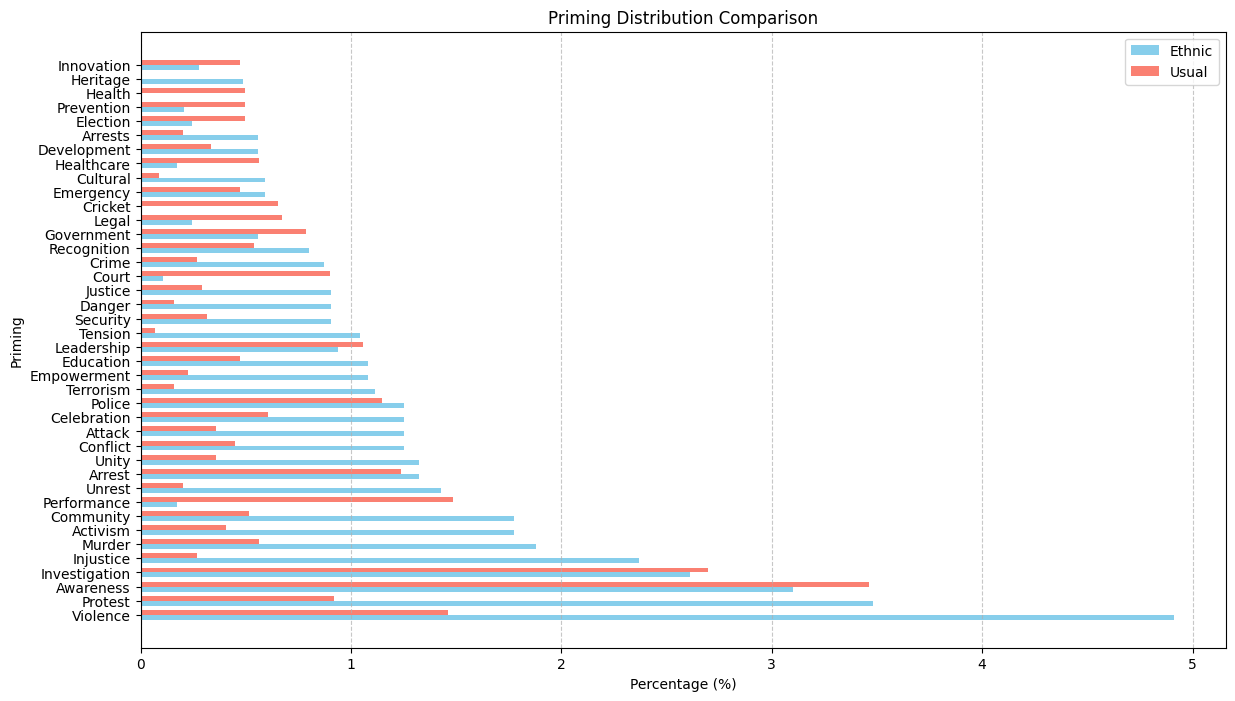
For mobilizing, there is not much difference. Dataset 1: 19.44% Dataset 2: 33.22% 
Annotation
We now need to annotate sentiment, agenda setting, framing, priming, mobilizing.
Paper dumps - Framing Evaluation and Noun encoding
For that, we consider universal sentence encoder (USE) to encode frames. Because frames are noun phrases, as evident from the frames identified in and . And according to Ajallouda et al., the best technique that can be used to represent noun phrases is USE . Next, we cluster these frames into a hierarchical structure using Agglomerative Clustering, ultimately isolating X top-level frames. We use silhouette score to find the optimal number of clusters to be X.
According to , framing is inherently nuanced. The intertwined nature of frames often leads to confusion among annotators, as a single news piece can contain multiple frames . This complexity makes it challenging to ensure that all frames are accurately captured during annotation. Additionally, a machine may detect a subset of frames or identify an overlapping but distinct set of frames. This scenario is best treated as a fuzzy or soft evaluation problem. A "soft match" occurs when a machine's prediction is considered correct if it matches any of the multiple frames identified by human annotators, even if the match is not exact or comprehensive. The Jaccard Index is used to estimate similarity between sets or sequences . And Binary indicators are also used across domains to represent true or false in a relationship between sets , . So we use Jaccard Index and Binary Indicator for match, here-forth called Binary Match Indicator as soft evaluation metric. In our case, BMI can be represented as:
$$
\text{Binary Match Indicator} =
\begin{cases}
1, & \text{if } \text{FrameX} \in \{ \text{Frame1}, \text{Frame2}, \ldots, \text{FrameN} \} \\
0, & \text{otherwise}
\end{cases}
$$
This metric represents match or non-match between machine and human annotation. So we can now use regular formula to calculate human-machine agreement rate . In our case, if we evaluate over M articles, we can calculate the Average Agreement Rate using the binary match as follows:
$$
\text{Agreement Rate} = \quad \frac{1}{M} \sum_{i=1}^{M} \text{Binary Match Indicator}_i
$$
Our human-machine agreement using Binary Match Indicator was 0.43. We also calculated Jaccard score to be 0.26. T
Experiment - Framing
We annotated 109 articles for 5-type framing. Our agreement score was around 86.23%. Our result in 5-type framing using LLM is:
| gpt-3.5-turbo, llm-paper |
50 |
49 |
50 |
47 |
| gpt-4o-mini, combined |
58 |
55 |
58 |
56 |
We now annoate 109 articles for 16 core frames we identified earlier from 1626 frames. The agreement score was ADITY. Our result using LLM is:
| gpt-4o-mini, combined |
0.371 |
This metric measures the similarity between the predicted frame set and the actual frame set. Its also called Intersection over Union.
Jaccard Index=Number of common frames / Number of frames in union of actual and predicted sets.
The Jaccard Index ranges from 0 (no overlap) to 1 (perfect overlap), making it suitable for fuzzy evaluations. We use Jaccard Index because this scenario can be considered a fuzzy or soft evaluation problem since the predicted frames are not required to exactly match the actual frame list but are instead considered correct if they are present within the actual frames. To evaluate such scenarios, you can use metrics that account for partial matches and the degree of overlap between the predicted and actual frame lists.
Despite the moderate Jaccard Index score, we still use LLM for frame identification because LLM can find most frames from an article. A human often overlooks and can't identify most frames, only focuses on few frames.
We now annotate 10k articles to find these frames.
Survey
Literature
Atuel, Hazel et al first proves representation discrimination and then, tries to provide an explanation for it using sociological literature . Georgiou, Myria et al first performs interviews and then summarizes their findings by quoting what particiapnts have said about certain topics . However, they do support those participants' claims empirically.
Bryant et al discussed the effects of media under-representation on minority groups. The findings indicate that televised portrayals of racial/ ethnic minorities influence majority group members’ real-world perceptions about minority groups as well as minority group members’ evaluations of self. The factors facilitating this learning process (perception) include frequency of television exposure, characteristics of the content/message, realism of the portrayal, similarity to the model, identification with the model, and level of individual cognitive ability (Bandura, 1986; Potter, 1986). Taken together, these variables provide one framework for understanding the extent to which the content and number of portrayals of minorities on television may result in judgment formation .
CDA
It focuses on linguistic devices or speech acts and how they serve powerful social groups to fulfill their interest
Van Dijk’S ideological square allows subtle analysis to express various ideological stances. It includes:
- Emphasise positive things about Us
- Emphasise negative things about Them
- De-emphasise negative things about Us
- De-emphasise positive things about Them
Behnam and Mahmoudy (2013) discovered the political ideology in Iran’s nuclear report through discourse structure. In determining the ideological structures, the presupposition concept was employed leading to a specific ideological structure. This can be depicted through the phrase: “Iran has not provided requested information…” (Kerr 2009, p.2). The phrase denotes a negative belief in Iran. Besides, another preference in which ideology can be determined is through repetitive words in the report such as undeclared, uncertainties, inconsistencies, and contamination. These words depict a destructive image for the country such as: a) Iran is trying to conceal information from the world view, and b) Iran is inconsistent in its nuclear program.
Ramanathan et al provided many more examples of CDA in their paper on "Applications of CDA" where researchers manually inspect articles to find bias towards certain idelogical stance .
When applied to the study of ethnic minorities, CDA often focuses on how these groups are represented in the media, politics, and public discourse. Key questions might include:
- How are ethnic minorities depicted in news stories? Are they portrayed in a negative or stereotypical manner? Are they underrepresented or misrepresented?
- What language is used to describe ethnic minorities? Are certain words or phrases consistently used to marginalize or otherize these groups?
- What ideologies are at play? How does the discourse reflect broader societal attitudes towards ethnic minorities? Does it challenge or reinforce existing power structures?
I think we can't use it because frankly, analyzing articles manually is time-consuming and will include my bias.
Question
Survey/Interview Topic: "Under-Representation in News Media and Its Impact on the Lives of Indigenous People in Bangladesh"
We intend to conduct a focus group discussion.
This is the informed consent form for the FGD. And This is the questionnaire for the FGD. And This is the presentation for guiding the FGD in an open-ended manner.
Case Finding
We need to delve deeper into analyzing the ethnic articles to find case studies to demonstrate clear discrimination. For it, we need to do the following tasks.
| Filtering only ethnicity related articles (OERA) |
ChatGPT |
| Finding sentiment in OERA |
Bangla, ChatGPT |
| Retracing article name, author and category for case study |
- |
| Use journalism domain analysis i.e. spokeperson, tone |
ChatGPT |
We can combine all of it into a single ChatGPT response. However, imo, this can be extended to our next task.
Additionally, finding case studies can greatly benefit from volunteers who are already working on it. They should already possess a large collection of such cases of discrimination, like the following. 
- News source 1
- News source 2
References

 We had the highest coherence score for alpha value around 73. So we get our final topic list from an LDA with coherence score = 0.7394. The topic list is below.
We had the highest coherence score for alpha value around 73. So we get our final topic list from an LDA with coherence score = 0.7394. The topic list is below.






 We validate our news genre distribution against work by Ross, Karen, et al. Their news genre distribution strongly correlates with our findings, except Sports genre
We validate our news genre distribution against work by Ross, Karen, et al. Their news genre distribution strongly correlates with our findings, except Sports genre  For
For 

 This model underfits for
This model underfits for  For govt actions topic:
For govt actions topic:  For protests topic:
For protests topic: 








 This topic distribution provides stronger support against our hypothesis. Now let us do word cloud. For protest and conflict, we got the following word cloud.
This topic distribution provides stronger support against our hypothesis. Now let us do word cloud. For protest and conflict, we got the following word cloud. 













